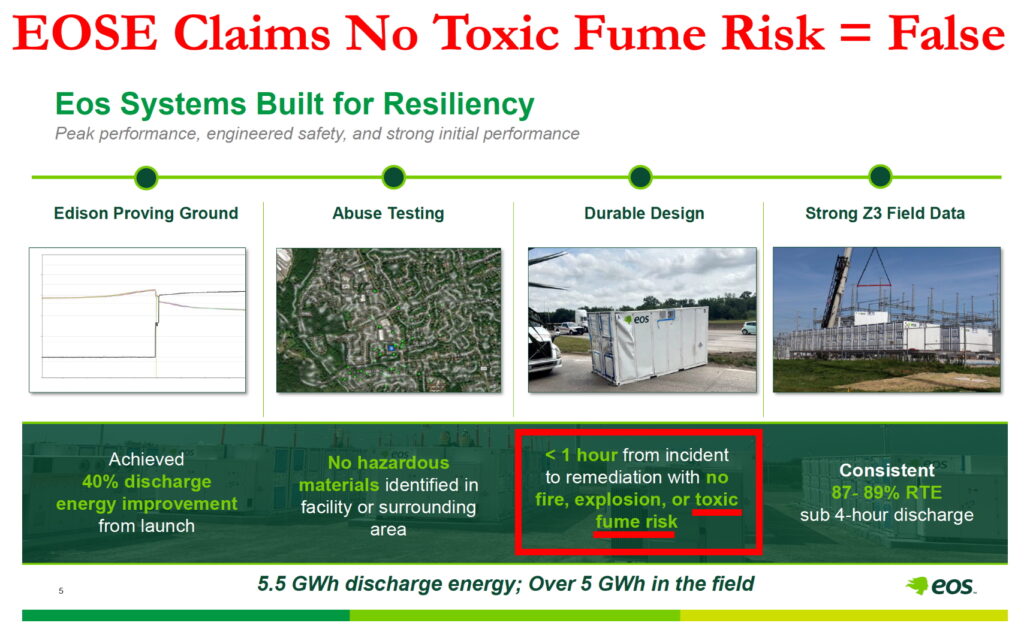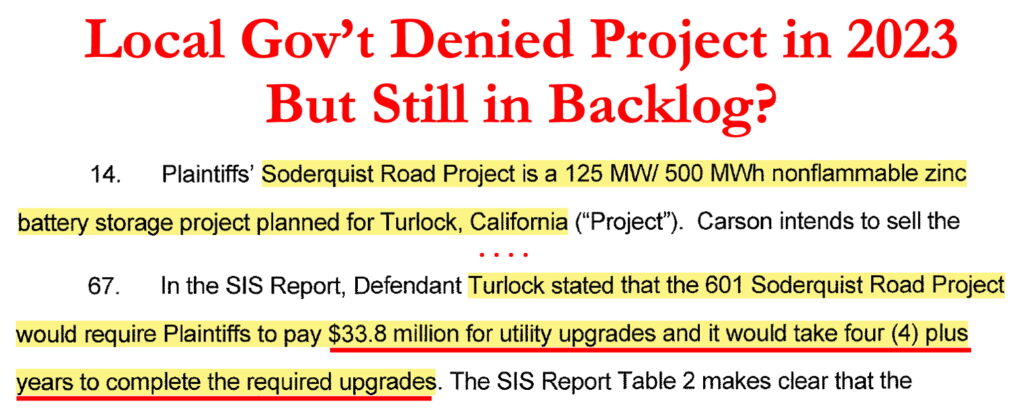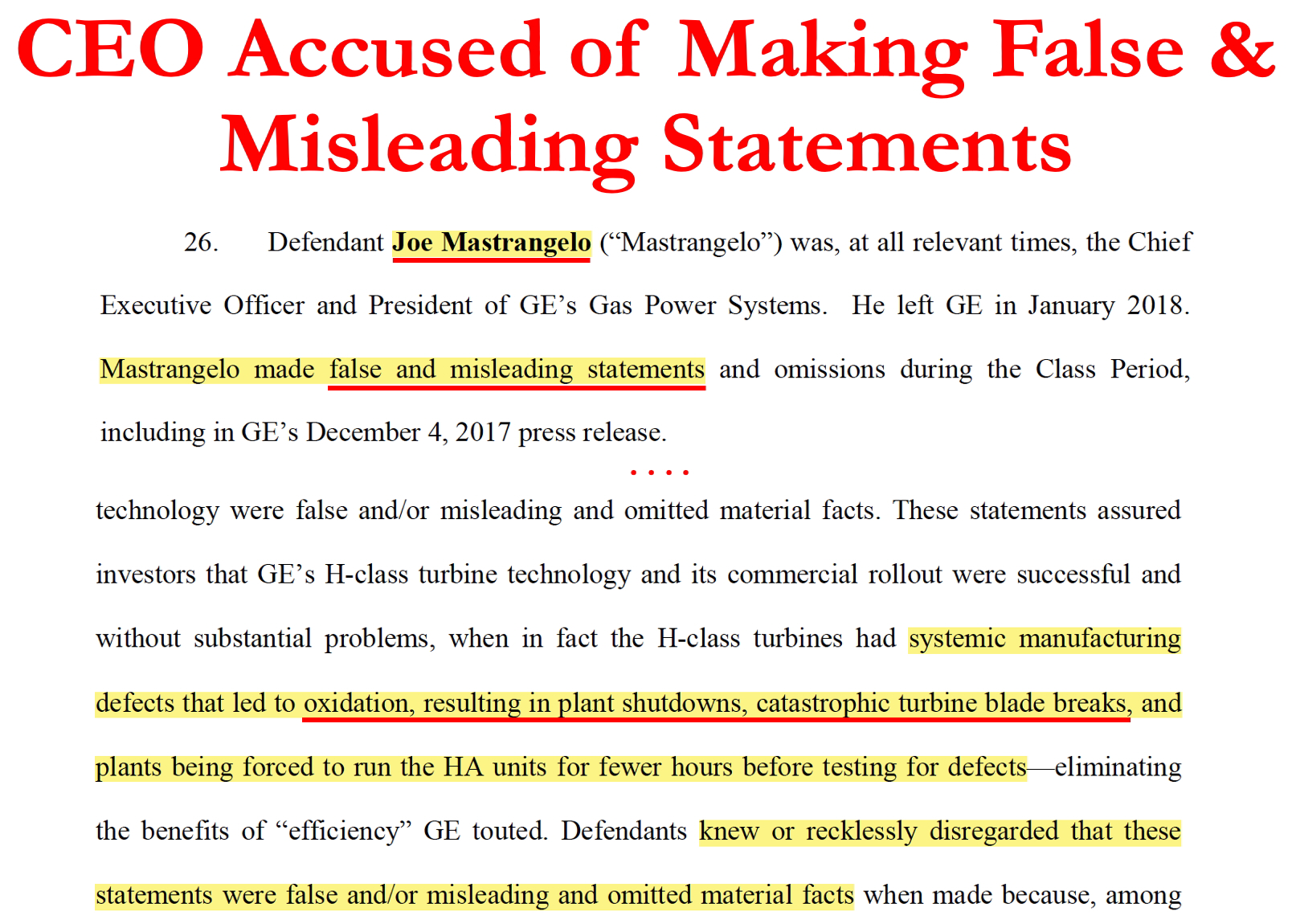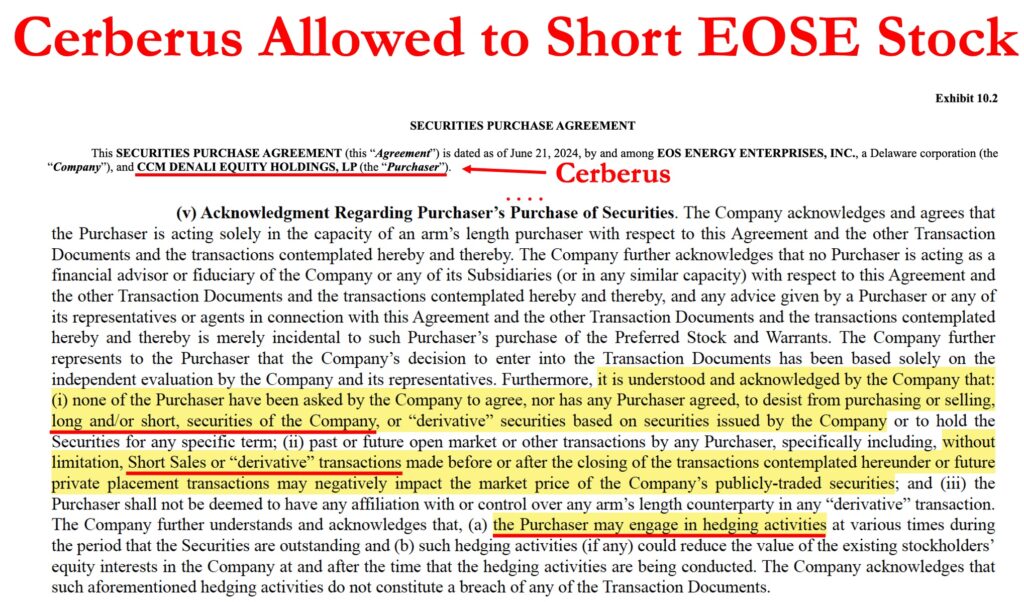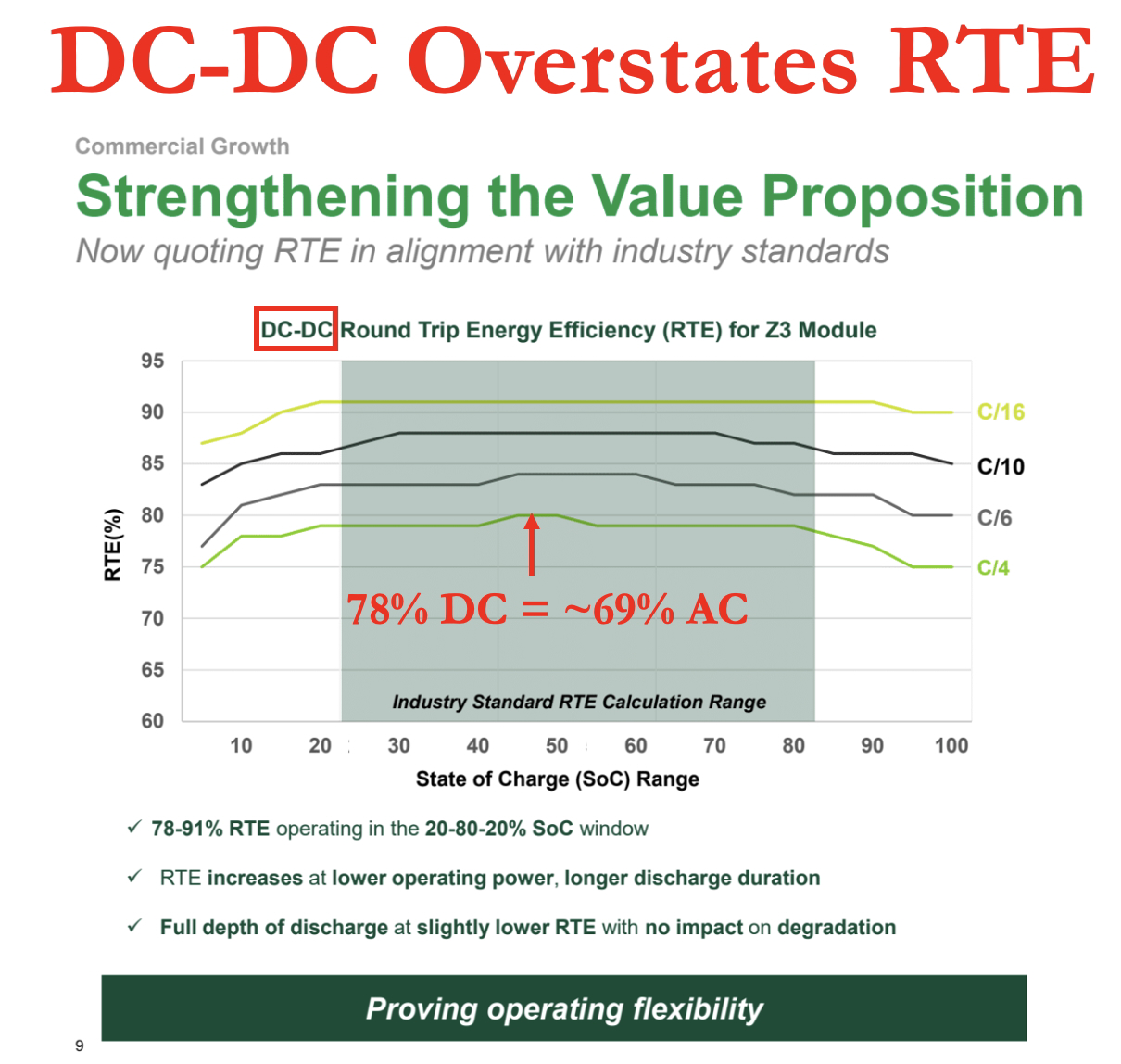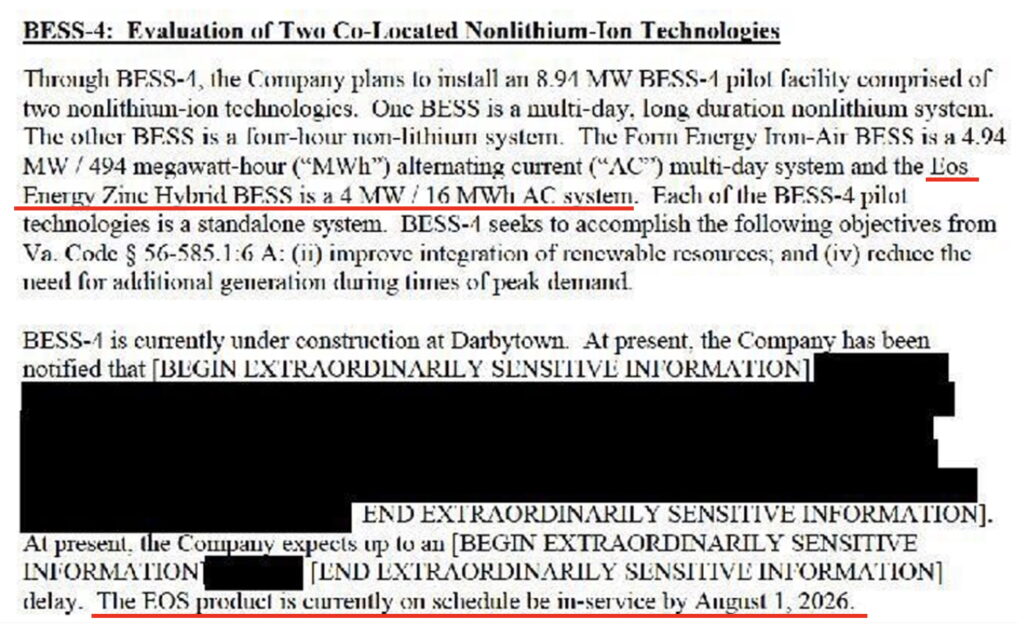- Eos Allegedly Gave False & Misleading Financials to the DOE = Default on DOE Loan
- We Expect DOE Loan to Be Pulled & Debt To Come Due Immediately
- Eos Has Three Different Sets of Financials – Major Red-Flag
- Deadly Gas Problem – Multiple Instances of Thermal Events & Hydrogen Bromide Gas Leaks
- Est ~80% Backlog is “Worthless”
- Permit Records, Legal Docs & Satellite Images Prove Most of the Backlog is Bogus
- Material Costs Revealed – EOSE Will Never Be Gross Margin Positive
We are short Eos Energy (EOSE) because we uncovered that the company has hidden a problem with leaks of deadly gas. Like many men with bad gas, Eos refuses to take credit for it. FOIAs and interviews with former employees and customers revealed multiple thermal excursion events that have happened with EOSE battery packs. Multiple thermal events have resulted in leaks of deadly hydrogen bromide gas.
But a deadly gas problem is not all that Eos management has been hiding.
Former C-suite executives informed us that Eos Energy has 3 different sets of the company’s financial model. The executives said it was a major red flag. and that the different models had drastically different financial projections that Eos present to different parties. We learned that Eos has allegedly been presenting the Department of Energy with false & misleading financial projections. We asked why. The answer: “We have to show the DOE this otherwise our loans are not going to get approved.”
Not only do we think Eos’ DOE loan from Biden is at risk of being pulled, but we believe that the DOE will declare a default on the loan. Our analysis shows that Eos is likely in violation of multiple DOE loan covenants. We think the allegedly false financial projections that Eos has given the DOE will be the final straw that prompts the DOE to pull the remainder of the loan. Loan docs show this is also an Event of Default that would cause the DOE Loan Balance to Become Immediately Due.
We are short EOSE after we uncovered:
- FOIAs & Formers confirm leaks of deadly hydrogen bromide gas from EOSE batteries
- Thermal events resulting in hydrogen bromide gas leaks occurred at multiple customers
- We have learned of >10 instances
- Hydrogen bromide gas is deadly – former’s say gas leaks PPM exceeded OSHA limits
- Formers said Eos management is hiding the problem & refuses to do needed safety studies
- Thermal events resulting in hydrogen bromide gas leaks occurred at multiple customers
- Eos keeps three different sets of financials
- Former C-Suite execs told us Eos presents different false and/or misleading financials to the DOE
- CEO Joe Mastrangelo ordered financials be altered to meet DOE loan terms – he had executives “goal seek for whatever is needed to be done” to ensure DOE released loan
- Executives said, “it was clear, we can’t do that”
- Eos in default of DOE Loan Covenants – DOE loan likely to be pulled & debt immediately due
- False statements or omissions to DOE = Event of Default
- Default Remedy = $90.9m in Debt Immediately Due?!? (~50% of Eos’s cash)
- Potential additional event of default from Eos violating affirmative environmental covenants. Former’s said hydrogen bromide gas leaks haven’t been disclosed to DOE
- Tranche 1 of DOE loan was only released due to Eos presenting overstated future demand. Eos should have never been allowed to draw down the DOE loan in the first place due to a lack of NTM demand.
- “[If the DOE] decides that that was done under fraudulent circumstances, they can claw back that money”
- DOE funding already pulled from 1 of EOSE’s customers’ projects
- DOE has already pulled funding from > 200 Biden approved projects.
- Customers Disclose Significant Performance Issues
- Low Round Trip Efficiency (Pine Gate had 42-55% RTE)
- Batteries had High Failure Rates (30-40%)
- Indian Energy found Eos Batteries had shorter lifespan than advertised
- NextEra received “Frankenstein’d” Batteries that looked like “rats nests” so NextEra sent them back
- ~80% of Backlog is “Largely Worthless”
- FOIAs, legal docs & interviews confirmed which Backlog Projects are currently dead
- “I would discount [the backlog] by 80%” ~former C-Level Executive
- CEO doesn’t want a paper trail regarding the backlog – Former’s said Joe demands that nothing bad about backlog be put in writing – no texts, no emails!
- FOIAs, legal docs & interviews confirmed which Backlog Projects are currently dead
- Major backlog projects that we believe need to be removed include:
- Pine Gate – “will not buy from Eos again” due to major battery performance issues (low RTE; gas leaks; premature tripping)
- Pine Gate is reportedly preparing to file for bankruptcy
- Carson Hybrid Energy Storage – We found the actual LOI!
- The LOI is just a “contemplated contract” BUT allows for a “Press Release” & “Promotional Materials”
- Local Gov’t blocked project >2 years ago & Satellite images show empty field
- Formers say the LOI “isn’t worth the paper it’s written on”
- One project, Faraday Microgrids, funding was killed after DOE canceled its grant
- Z-Global – “I don’t think we have ever used Eos”
- EnerSmart – website shows they dropped Eos & switched to lithium-ion
- We uncovered Multiple IEP Projects that are unlikely to occur:
- Documents & interviews revealed IEP is crash strapped & run by a friend of Eos CEO
- Former’s said IEP was “not real,” & a “waste of time”
- Bridgelink – Bridgelink Investments Website Highlighting Eos No Longer Exists! (webarchive)
- Yet “[Eos] were still very much accounting for that…like why is this in [backlog]?”
- Bridgelink was the center of previous backlog controversy after its parent co went bankrupt. Former’s say somehow Bridgelink is still in the backlog even though none of the projects have been developed
- Bridgelink chairman now co-CEO of an energy storage pink sheets paid stock promotion that plans to use lithium
- Pine Gate – “will not buy from Eos again” due to major battery performance issues (low RTE; gas leaks; premature tripping)
- Why is Eos’s backlog NOT filled with legit funded & permitted projects? Because lithium ion performs better & is cheaper
- Eos Batteries est to cost at least 2x MORE than lithium
- Lithium Has Better Round-Trip Efficiency — Eos RTE estimated at ~30-35% Lower Than Lithium.
- Other zinc bromide battery company’s went bankrupt due to bad economics.
- Eos Batteries Are Uneconomic – Material Costs Higher Than Sale Prices!
- Formers & battery experts revealed Eos’s material costs
- Estimates of costs at scale show material costs are still higher than the selling price
- Only hope for profits is if pricing increases. But pricing is DOWN 38%-68%
- Formers actually laughed at the idea of Eos becoming Gross Margin Positive. Told us it would never happen
- The more Eos sells, the more money it loses!
- CEO Joe Mastrangelo’s described as having a Weak “Moral Compass”
- Eos churned through 4 CFOs and 3 CCOs in 5 Years
- Execs who deliver negative news risk being fired
- CEO insisted defunct projects stay in backlog, refused to write down obsolete inventory
- Cerberus Wins Even if Eos Shareholders Lose
- Misrepresenting Financials to DOE results in Event of Default on Cerberus Loan too
- Disclosures show Cerberus Can Short EOSE & Hedge positions
- Formers Say Inventory Needs to be Written Down & Revenue Restated
- Eos allegedly “double” counted revenue from NextEra batteries it had to replace
- Executive’s est ~25% of inventory is useless
- ~$11 million of unusable battery fluid was left in inventory. Joe didn’t want it written down so is claiming it can be diluted
- Large Guidance Miss for FY 2025 & More Disappointment for FY 2026
- Eos Should Cut FY 2025 Guidance on Q3 CC
- FY 2026 Revenue ~95% Below Wall Street Est
Investors have piled into Eos’s stock in hopes that the company will be one of the pick-and-shovel winners for AI data centers. They picked the wrong energy company, and they’re about to get hit in the face with a shovel. Eos has a broken order book, is hiding a deadly gas problem, and we learned it has been sending false financials to the DOE. This not only puts the DOE loan in default but could cause Eos’ debt to be immediately due and payable. We’ve shared our research with the DOE.
Another battery company with a grant/loan from the Biden administration was American Battery Technology Company (ABAT). ABAT had its DOE grant pulled the other week and its stock fell ~50%. We are short EOSE because we believe its situation is even worse with the DOE debt likely to become immediately due.
Fuzzy Panda Research is Short Eos Energy (EOSE)
Fuzzy Panda Research and Fuzzy Panda “Affiliates” are short securities of Eos Energy (EOSE). Please see additional disclosures at the end of report and in our terms of service.
Former Eos Energy employees or whistleblowers who wish to speak with us anonymously should reach out at [email protected]
PART I – Deadly Hydrogen Bromide Gas – Short Eos Energy
FOIAs, Former Execs Say Eos Hiding Thermal Meltdowns That Release Potentially Deadly Hydrogen Bromide Gas
- Former Executives Say Eos Batteries “Melt Down” & Leak Deadly Hydrogen Bromide Gas
- Eos Investor Deck Falsely Claims No “Toxic Fume Risk”
- Former Executives Say Eos Refuses to Do Needed Safety Studies
“In several instances, [hydrogen bromide] was in excess of 100 parts per million … you’re literally riding the razor’s edge on whether or not you’ll kill somebody” ~Former EOS Safety Executive E
“Hydrogen bromide is extraordinarily toxic … it can kill you” ~Former Eos Energy Safety Executive E
Eos Energy pitches its batteries as safer than competitors’ lithium-ion technology. But it is hiding a different safety problem. We learned from FOIA requests, former employees, and Eos customers that during thermal meltdown’s EOSE’s batteries release a toxic and potentially deadly gas called hydrogen bromide.
We have learned of >10 incidents during which the batteries emitted the toxic gas.
FOIA’s of Local Fire Department Confirms Multiple Instances of Eos Batteries Shorting & Off-Gassing Hydrogen Bromide

The fire department and paramedics had to respond to incidents at the Eos headquarters in NJ and its factory in Pennsylvania, and workers had to receive medical treatment. Eos evidentially also had to close the facilities for up to a week to let the gas clear out, former employees said.
“I was very frustrated. [Management] wouldn’t take [the gas leaks] a little bit more seriously and at least, you know, have more open and honest discussions about what the potential [risk] is…I think they’re an ostrich. They’re burying their head in the sand and hoping that [gas leaks] never becomes a problem” ~Former Eos Operations Executive A
Former Eos employees said the batteries could spew gas that had 10x OHSA’s safe limit for hydrogen bromide exposure.
Thermal Events with Hydrogen Bromide Leaks Occurred at Multiple Eos Customers
“We had many, many [off-gassing accidents]. One at Pine Gate Renewable. We had a couple in California … at Viejas. We had another one down in Texas at Orchard” ~ Former Eos Operations Executive B
Speaking to former employees and customers, we have uncovered >10 incidents in which thermal events led to Eos’s batteries leaked toxic off-gassing.
We uncovered incidents at:
- Pine Gate Eastover project in SC – multiple incidents
- Eos HQ in NJ – multiple incidents
- Eos Factory in PA – multiple incidents
- IEP Orchard project in Texas – at least one incident
- Indian Energy’s Viejas project in CA – a “couple” of incidents
- Incidents at Azure Power’s project in India
- Incidents at Motor Oil Hellas in Greece
We have good reason to believe there have been more incidents. Please email us at [email protected] if you know of any additional incidents or if you have been harmed by one of the incidents.
Customers Call Management’s Claims of No Toxic Fume Risk “Misleading”
Eos customers told us that they were misled by marketing that said the company’s batteries have no risk of emitting toxic fumes. Pine Gate Renewables found out the hard way when its Eos batteries had off-gassing issues at its battery farm.
“The off gassing is something that we [Pine Gate] discovered … that they’re marketing it as like no hazardous off gases would seem a little misleading” ~Former Pine Gate Engineer
Eos cannot claim it did not know about the gas problem. It has had multiple incidents at its own NJ headquarters and PA factory, former executives told us.
Eos’ own investor deck from Q2 2025 makes what appears to be a false statement saying there is “no risk of toxic fumes.”
Eos Management Ignoring Gas Dangers, Former Executives Said
“Nobody’s really spent the time to study the problem” ~Former Eos Operations Executive A
Former Eos executives told us that management was not studying the gas problem. They said Eos was simply relying on its outsourced control software to regulate battery temperature to avoid melt downs and gas spewing into the air. But that has not yet worked, and the former executives said it was not a realistic solution to a serious safety problem.
“I don’t think that they were addressing it in the seriousness that was required… there was an overreliance on the software” to control the problem ~Former Eos Energy Safety Executive B
Eos Batteries Have Also Leaked Toxic Fluid Near Local Waterways
Former employees said that Eos has improperly dumped its old or non-working batteries into the garbage at its factory in Turtle Creek, PA, and the toxic zinc bromide electrolyte leaked into a nearby creek, which we confirmed via FOIA.
“You could see the stains on the driveway of the electrolyte leaking out of the dumpster] ~Former Eos Energy Safety Executive E
We were also told of the batteries splitting open and spilling electrolyte into the soil at customers’ sites.
PART II – DOE Loan Likely to Be Pulled – Short Eos Energy
Eos Tripped DOE Loan Covenants Via Sending False Financials: Recourse = Loan Pulled & Debt Immediately Due
- EOS Has 3 Different Sets of Financials – C-Suite Execs Said Inflated Projections Sent to DOE
- Loan Analysis Shows Multiple Debt Covenants Likely Tripped
- Expect DOE to Pull Loan & Debt to Come Immediately Due
“We have different [company] models because we have to show the DOE this otherwise our loans not going to get approved… I don’t know why we’re showing a different [financial] case to different constituents. And it’s pretty clear that we can’t do that.” ~Former Eos C-Level Executive C
A former C-Suite executive revealed to us that Eos keeps three different versions of its financial models. It was a huge concern of theirs. They said it wasn’t just something where Eos just had a base case, downside, and upside case. Instead, the different financials had vastly different financial projections for different audiences. They said this allowed Eos to present inflated numbers to the DOE and got them to release tranche 1 of its $303 million loan.
According to former executives, CEO Joe Mastrangelo, directly told employees to manipulate the financial model and to adjust future revenue projections reported to the DOE in order to hit key DOE CP’s (Condition Precedents) for the loan.
CEO Allegedly Got Executives to Alter Financials Sent to DOE to Show Eos Achieving DOE Key Terms It Was Set to Miss
Mastrangelo Overruled Executives Who Pushed Back
“They will do whatever they need to do in the model to show … that those condition precedents are going to be met. Some of the CPs are EBITDA based, some are revenue based, some production based…So [Eos will] goal seek for whatever is needed to be done” ~former Eos C-Level Executive C
Earlier this year, Mastrangelo told executives to falsely claim a project was coming online earlier than planned to ensure quarterly revenue met the DOE requirements to release a tranche of the loan. Here is how they recounted the exchange:
CEO – Joe Mastrangelo: “Why is revenue in this quarter below the threshold for the DOE? … Let’s move the timing of when this [revenue] line comes online so it shows that we meet” the DOE loan conditions.
Former C-Level Executive: “But Joe we can’t meet that timing, it’s impossible, the vendors aren’t going to … that’s also not what we’re showing Cerberus.”
CEO – Joe Mastrangelo: “It doesn’t matter. This is what we need to do”
False Statement & Omissions to DOE = Event of Default
Based on the DOE-Eos Energy loan document, providing false or misleading statements to the DOE constitutes an Event of Default.
Senior management have confirmed to us that Eos regularly provided different inflated financials to the DOE so we believe that once the DOE uncovers these false statements that they will cease lending to Eos for future tranches and the DOE will declare an “Event of Default” on the loan.
Spoiler alert – we have already contacted the DOE as well as members of administration’s DOGE division.
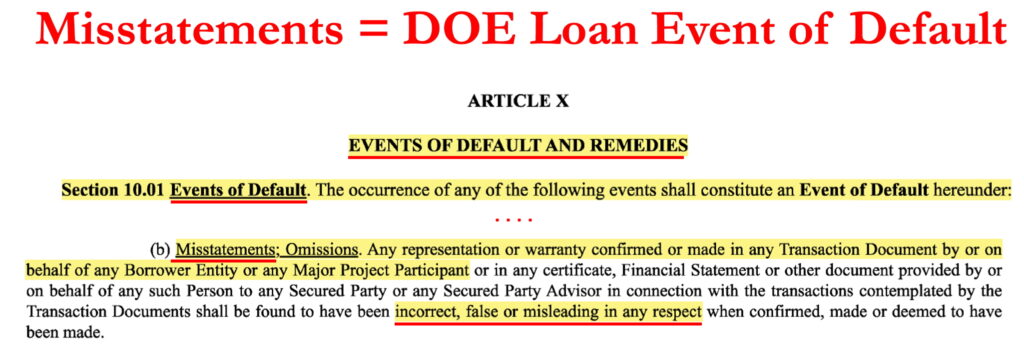
Event of Default Remedy = $90.9m in Debt Immediately Due?!
Loan Documents show that a potential remedy for the DOE declaring an event of default on the Eos Energy loan is that all the issued debt is declared immediately due and payable.
The cost for Eos sending the DOE a different set of financials could be that they are forced to pay back the $90.9 million of debt immediately. That would wipe out a majority of Eos’s current cash balance.

More False Statements to DOE? Is Order Book Inflated to Drawdown DOE Funds?
“The DOE, if they determined that it was fraud, can claw back that DOE loan or however many funds they have released…If they decide that that was done under fraudulent circumstances, they can claw back that money” ~former Eos Safety Executive E
Another clause in the DOE loan is that Eos has to report the next 12 months of demand to the DOE. Eos can only drawdown the loan that is necessary to build capacity to fulfill that demand. We believe this could be one of the major reasons why Eos has been inflating their order book and clearly leaving customers with highly unlikely projects in their backlog.

We also believe this is why management pulls the rug on investors every quarter by not bringing down their guidance.
DOE Loan Should Never Have Been Drawn Down – Est Real Demand Was ~40% Below Capacity
The DOE loan only allows Eos to draw down tranches of the loan to fulfill demand for the next 12 months that can’t otherwise be fulfilled with current production capacity. We estimate that Eos’s actual demand was only 60% of previous production capacity when the loan was given. The DOE loan should never have been drawn down in the first place.
Based on our analysis and former employee commentary about what percentage of backlog is false, we estimate Eos only had actual demand of ~340MWh at the beginning of the year. Eos claimed to have the capacity to produce 1,250MWh after installing their first automated manufacturing line (they used DOE money for this). Before that they claimed capacity to produce 540MWh.
The only way they’ve been able to get the DOE to provide funds is allegedly by providing false projections based on a backlog that former employees told us was largely fictitious.
If Toxic Hydrogen Bromide Gas Risk Was Not Disclosed, Then DOE Has Another Cause for Default
Former employees told us that they believed that Eos had NOT disclosed the risk of toxic and potentially deadly hydrogen bromide gas being released to the DOE. This would be another cause for default as the DOE-Eos Loan documents have multiple affirmative covenants that require reporting to the DOE.
- Section 6.24 – Environmental Laws
- Section 8.02f – Environmental Reports
- Section 8.03 on notification of environmental notices
- Section 5.04 Advance Approval Conditions – (u) Environmental Compliance:
We believe if the government knew the truth about EOSE’s backlog, environmental problems, and how the financials they have been presented were “adjusted” then the DOE would have declared default and declare that Eos Energy has to repay funds that never should have been dispersed.
The DOE has already done a massive cancellation of Biden approved financial awards. This even includes one of Eos’s customers’ awards being canceled.
PART III – ~80% of Backlog is ‘Worthless’ – Short Eos Energy
The Backlog is BS – FOIAs and Legal Docs Prove Projects are Defunct; Formers Say It Is “Largely Worthless” – Discount It By ~80%
- CEO Forbids Negative Comments About Backlog in Email or Text Because Then He Has to Acknowledge Them
- Largest Real Customer’s Employees Said, “Won’t Buy from EOSE Again” Due to Significant Battery Problems
- Major Backlog Customer = LOI For a “Contemplated” Deal
- Project Was Blocked by Local Government >2 Years Ago
- Formers Said the LOI “Isn’t Worth the Paper It’s Written On”
- Another Backlog Customer Has Dropped EOSE and Switched to Lithium-Ion
“The pipeline number is just nonsense. That’s just made up … [Eos’s] backlog is largely worthless … I would discount it by 80%” ~former Eos C-Suite Executive C
We spoke to multiple former Eos Energy executives, and we consistently heard that the reported backlog number was not to be trusted. Meanwhile, disclosure around which companies and projects are included in the backlog calculation has continued to decrease.
Executives told us:
- “There’s very little in the backlog that actually has any teeth” ~former Eos C-Level Executive C
- “The LOIs are about as functional and as useful as a pre-approval document from a mortgage lender…it isn’t even worth the paper it’s written on” ~former Eos Safety Executive E
- “Do I think there are things in Eos’s backlog today that they know aren’t going to happen? …Yes, of course” ~former Eos C-Level Executive D
We also learned that “[Joe Mastrangelo] doesn’t want anything associated with the backlog in texts or emails…never putting it in writing form.” They said that Joe doesn’t want to ever have to announce order cancelations on earnings calls, and apparently Joe thinks that if executives only tell him verbally and not in writing that he doesn’t need to remove the garbage from the backlog.
So we have compiled a list of all the unlikely to occur bad backlog customers and projects that EOS has hyped. Joe, this list is in writing. It uses public records, FOIAs, and first person interviews as it’s sources to prove your reported backlog number is bullshit.
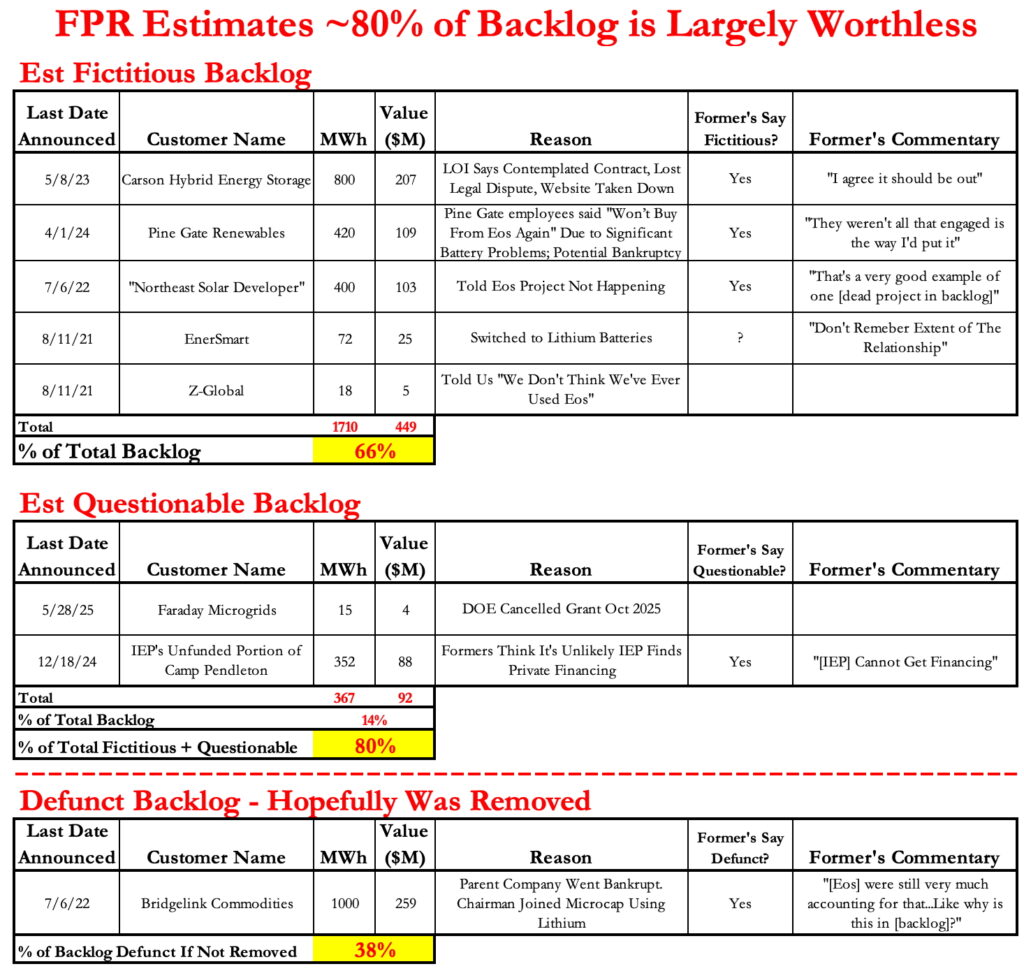
The Est Fictious Backlog – Dumb & Dumber – Former’s Say There is No Chance
Industrial Backlog is supposed to be a key measure of performance and future secure orders. Instead, Eos’s backlog reminds us more of false hopes and dreams. Joe seems to be taking a page from the movie “Dumb & Dumber” when he reports backlog … “So you’re telling me there’s a chance.” No Joe, there is virtually no chance, those busted LOI’s you are reporting as backlog are even less valuable than a briefcase full of IOU’s.
EOSE has been questioned by short sellers for multiple years regarding the quality of their backlog, but now we can prove how many of the projects are dead or dying.
Major Backlog Customer Busted – Carson Energy: LOI Is a “Contemplated Contract” & Project was Blocked by Local Court
One of the biggest pieces of EOSE’s backlog is Carson Hybrid Energy Storage (CHES) which has no business being included. The project was blocked by the local public utility in a California legal dispute.
After local courts blocked the Carson Hybrid speculative project from continuing. Carson tried to sue the local public utility. Carson lost the case, appealed, lost again, but not before they published the actual Eos Energy LOI that former employees told us is still being used as a cornerstone of Eos’s reported backlog.
The Actual LOI = Contemplated Contract, Not Extended into Binding Document BUT Press Release & Promotion is OK
Carson is a great example of backlog projects that formers told us, weren’t “worth the paper it’s printed on.”
In this LOI, Eos management pulled a cute trick. The LOI starts off saying it’s a binding LOI. But unfortunately for Eos, both us and lawyers know how to read. It turns out the Carson LOI is actually a “contemplated contract” about a location where a speculative developer “could deploy” energy storage and the LOI goes on to say it has not been extended into a “binding definitive document.” The LOI is also cancelable with 5 days notice by Carson with no financial penalties.
However, there is a clause in the LOI allowing a press release and other promotional materials.
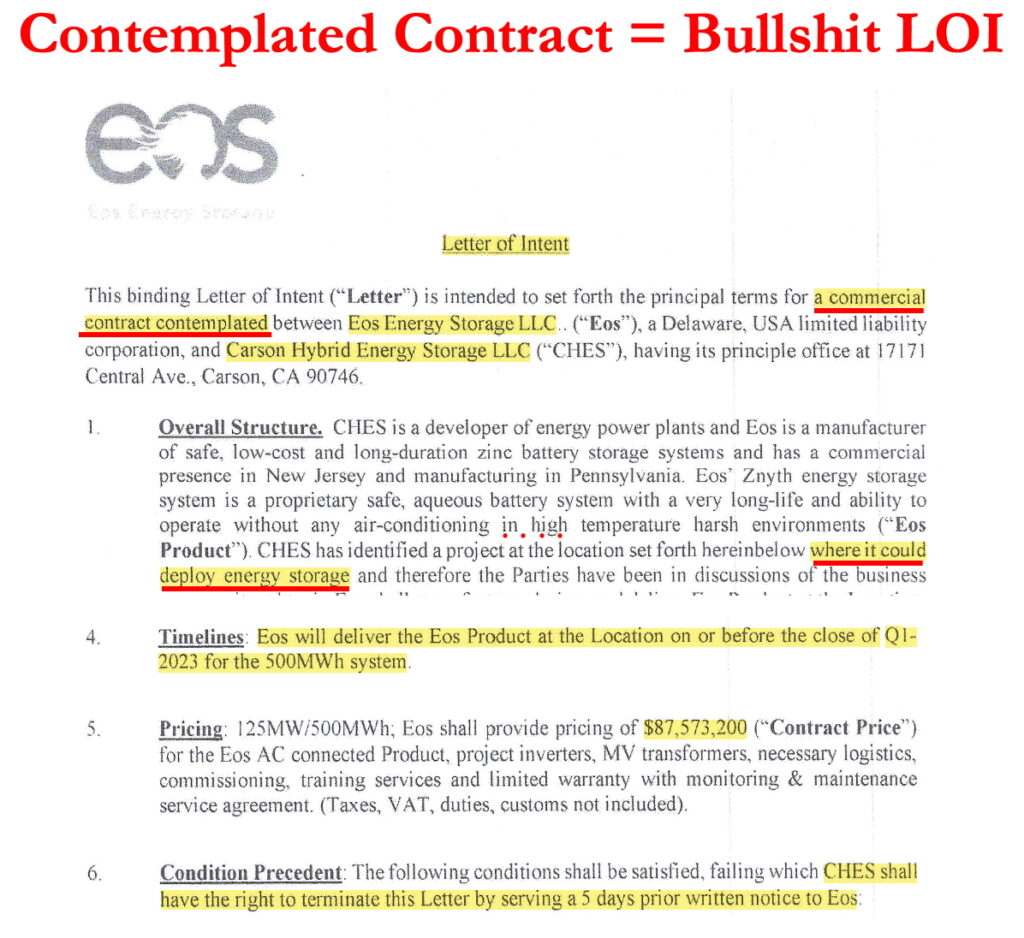
The LOI Goes on to Say it is NOT a Binding Definitive Document
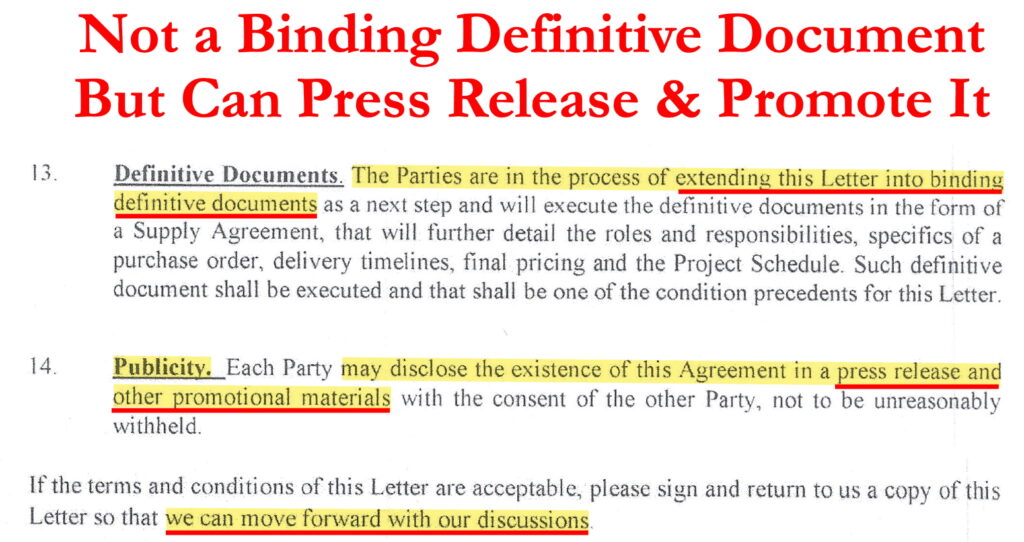
Local Utility Denied the Carson Project in 2023 & Won in Court BUT Former Executives’ Say It’s Still in Backlog
In 2023 the court ruled in favor of Turlock Irrigation District (TID). CHES appealed the ruling and has been fighting this legal dispute for over 2 years now, but the court still sided with TID – as recently as Sept 2025.
Given that CHES’s website was shutdown in Sept 2025, we think they’ve succumbed to defeat.
Recent Satellite Image Shows Carson Project Site is an Empty Field
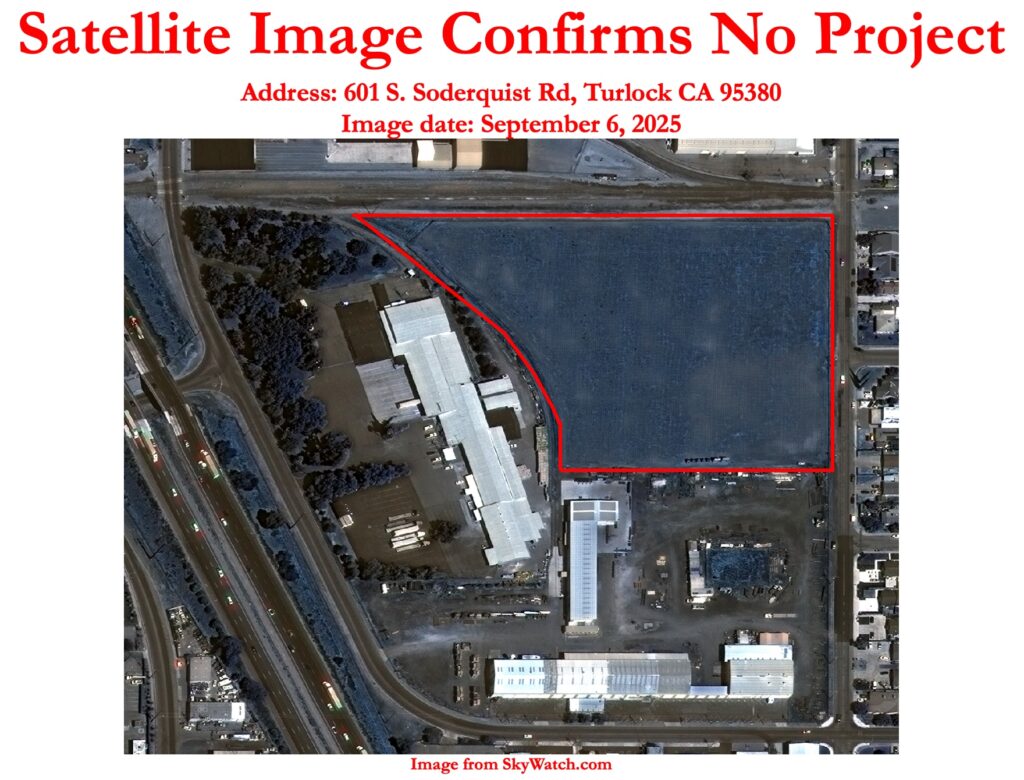
Eos supposedly had a 2nd project with CHES for 300MWh, but we cannot find any documents regarding this project on CEQAnet – indicating the project hasn’t even broke ground.
We asked recent former Eos executives if Carson was still in the backlog:
“[Carson still is] just because they [Eos] don’t want the [backlog] number to go down until they replace it with something else. I agree it should be out” ~former Eos C-Level Executive C
This project that never got off the ground years ago somehow still accounts for ~31% of EOSE’s backlog.
Pine Gate “Won’t Buy from Eos Again” & Is in Financial Distress: ~420 MWh of Backlog That Went Up in Smoke:
- Multiple Pine Gate & Eos Employees Told Us Pine Gate Was Unhappy with Eos
- Significant Battery Problems Including Gas Leaks
- Low Round-Trip Efficiency’s <42-55% Caused Pine Gate to Lose Money
- Pine Gate Reportedly Preparing for Potential Bankruptcy
- ~16% of Backlog That Should Be Removed
Pine Gate Renewables is known as EOSE’s largest actual customer to date. Their partnership was first announced in Nov 2021 for a 300MWh project, which was later increased to 500MWh in April 2024. Only ~80MWh was delivered in 2022, and according to interviews of multiple Pine Gate employees and former Eos executives we learned that Pine Gate has no plans to purchase any additional EOSE batteries.
- “There are problems with the [Eos] project that we had. Due to that I don’t think [Pine Gate] will be buying [more from Eos]” ~former Pine Gate Engineer
- “There was enough ill will on the problems with the first iteration of batteries that [Pine Gate] did NOT want to consider Eos again” ~former Pine Gate Executive
- “I would not have [Pine Gate in backlog], they weren’t very engaged.” ~former Eos C-Level Executive C
- “When you have low efficiencies, you’re basically losing money” ~former Pine Gate Engineer
Former employees told us Pine Gate experienced major issues with Eos batteries:
- Round-Trip Efficiency Significantly Below Advertised (42-55% vs. Promises of 75%+)
- Premature Tripping Caused Batteries to Shut Off With 20% Charge Remaining
- Off Gassing of Hydrogen Bromide
Additional proof of Pine Gate moving on from Eos is that they haven’t used EOSE in future battery projects since, such as the Sunstone project in Oregon. But even if Pine Gate was happy with Eos, Pine Gate is a customer that should be removed from the backlog since they are reportedly in financial distress. Bloomberg reported in Sept 2025 that Pine Gate is preparing for a potential bankruptcy.
We estimate Pine Gate currently accounts for ~420MWh of EOSE’s backlog, or ~16% of the total backlog that should be removed.
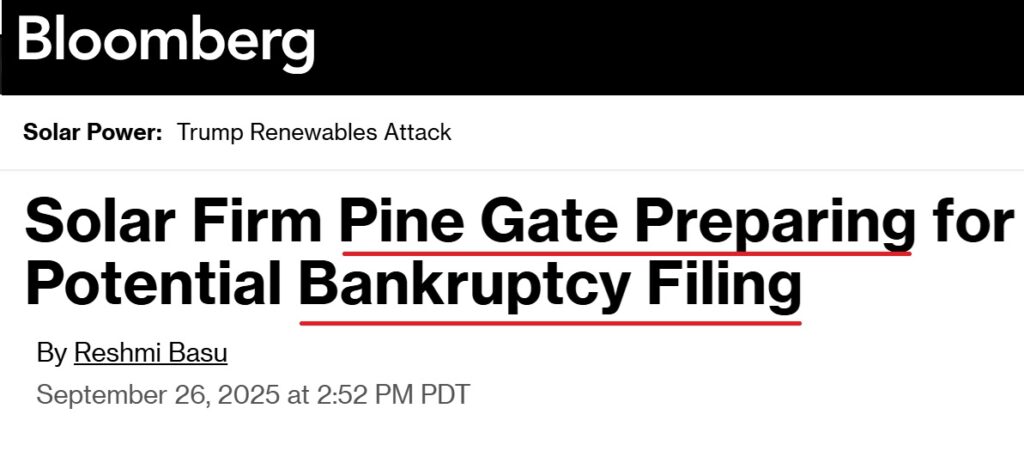
Formers Say Undisclosed Northeast Solar Developer Told Them “This Project Isn’t Going to Happen”
Eos announced a 100MWh order and a 300MWh MSA with an undisclosed “Northeast Solar Developer.” A former Eos executive told us Eos’s undisclosed northeast solar developer is apparently BlueWave Solar.
“They [BlueWave] said look, this project isn’t going to happen… I would be utterly shocked if BlueWave Solar is still in the backlog” ~former Eos C-Level Executive D
Matching up press releases with reported backlog in investor presentation we believe that BlueWave was added to the backlog number but never removed. If BlueWave remains in Eos’s backlog at 400MWh then that represents another ~15% of backlog that should be removed.
Customer That Switched From Eos to Lithium in 2023 But is it Still in Eos’s Backlog?!? Gov’t Docs & Website Confirm Eos Was Dropped
EnerSmart has been listed as a $25 million customer by Eos. But EnerSmart has long since moved on. EnerSmart’s website and local government reports confirm that EnerSmart switched to lithium batteries.
In August 2021, Eos said they’ve closed on 8 projects with EnerSmart for 72MWh (~3% of backlog) with deliveries to begin at the end of 2022.
EnerSmart Dropped Eos in 2023
EnerSmart lists their partners on their website. And in 2023, they switched their battery provider from EOSE’s zinc-based batteries to BYD’s lithium-based batteries. And EnerSmart’s promotional video of their first ever project (Chula Vista) shows a lithium-based battery (19 seconds). EnerSmart’s website shows they have 8 projects which use lithium-ion batteries.

We also pulled local government documents for EnerSmart’s projects, just to make extra sure that Joe has written documentation of which companies should or should not be in the backlog. Those documents confirm EnerSmart’s plans to use lithium-based batteries.
Backlog Customer, Z-Global – “I Don’t Think We Have Ever Used Eos”
In April 2021, EOSE announced a booked order from Z-Global for projects in California. And in their Q2 2021 investor presentation, EOSE showed they have 2 projects with Z-Global for 18MWh valued at $6 million. Z-Global’s website lists their 13 projects. We don’t see any projects located in California since 2021 that used non-lithium-ion batteries for storage.
We reached out to Z-Global since EOSE hasn’t mentioned the company since the initial PR.
Z-Global, said “I don’t think we have ever used Eos.”
DOE Cancels Eos Project in October 2025 – Faraday Microgrids – Will That Get Removed from the Backlog?
Charge Bliss (d/b/a Faraday Microgrids) received ~$30 million of funding from the CEC for their Paskenta Band project which they contracted with EOSE for battery storage.
On Oct 1, 2025, the DOE terminated Charge Bliss’ $30 million grant.
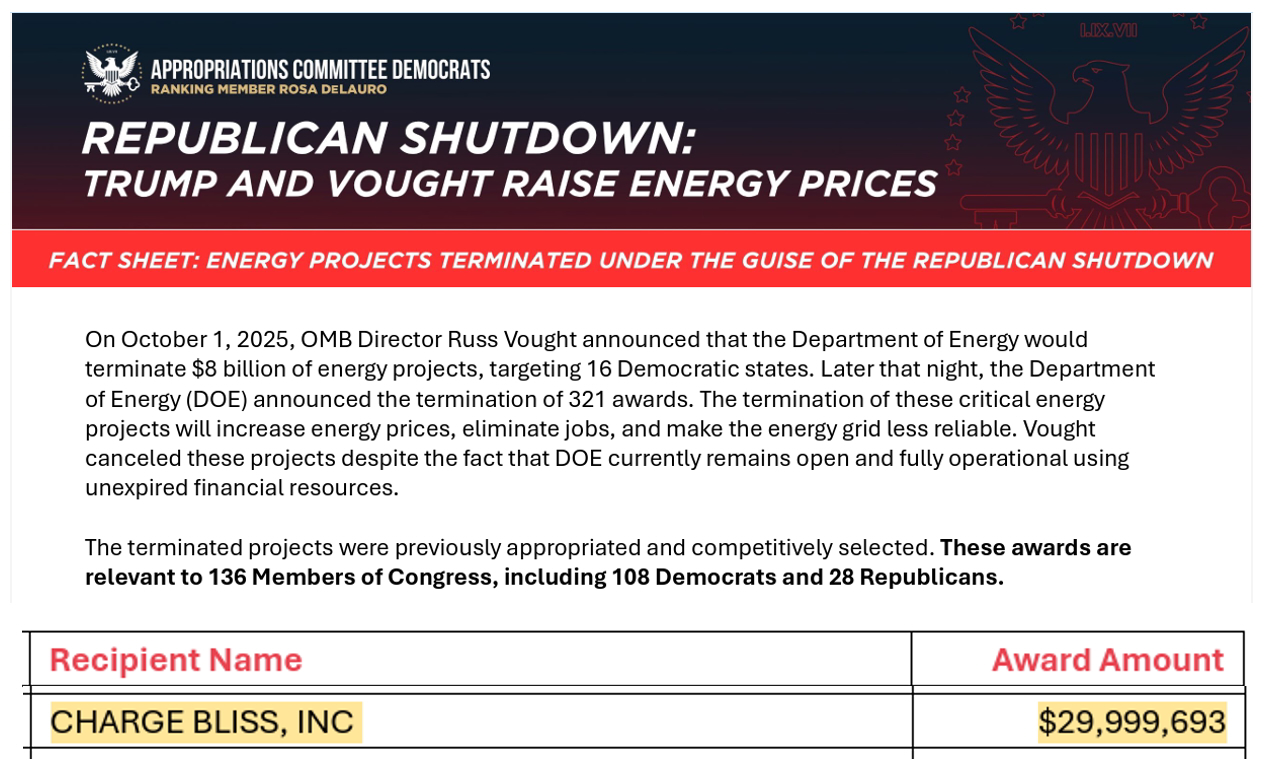
Questionable Backlog – I.E.P. – The Improbable Energy Projects
- Multiple Eos Projects Hinge on IEP – Former Eos Executives Said, “IEP is Not Real” and a “Waste of Time”
- Only 251k of Cash on IEP’s Balance Sheet
- Most IEP Employees Don’t Actually Work Full-Time For IEP
- IEP CEO has a Long Record of Outstanding Tax Leins
A large percentage of Eos Energy’s deals rely on IEP and their CEO, Peter Dailey, a person that was described to us as both a long-time friend of Joe’s but more importantly someone that Eos Executives thought was a “shyster.”
“IEP is not real…Peter Dailey [IEP Founder] is a good example of the people that they [Eos] spend their time with and waste time on. That’s just not going to move forward. And Peter cannot get financing from at least anyone that I’ve seen so far” ~former Eos C-Level Executive C
Despite entering into a 1,000MWh supply agreement in 2020, only 1 of the IEP projects has come online (IEP Orchard) for only 50MWh which Eos had to provide the upfront funding for and IEP sold the project before it became operational. For the 1 other IEP project that is permitted & partially funded (IEP Camp Pendelton) the majority of the 48/400MWh is coming from the CEC.
“Do I think this stuff [IEP projects] is real? There’s an awfully good chance it’s not because Peter’s a little crazy. And as I say, it feels like a shyster … If you met them [IEP], you would say, no way. I’m not betting any money on these guys” ~former Eos C-Level Executive D
IEP’s Broken Balance Sheet – Only $251k of Cash
We sent in FOIA’s to the California Energy Commission and in addition to information on Camp Pendleton they sent us IEP’s historical financials & balance sheet. In FY 2024 IEP’s cash balance is only ~$251k.
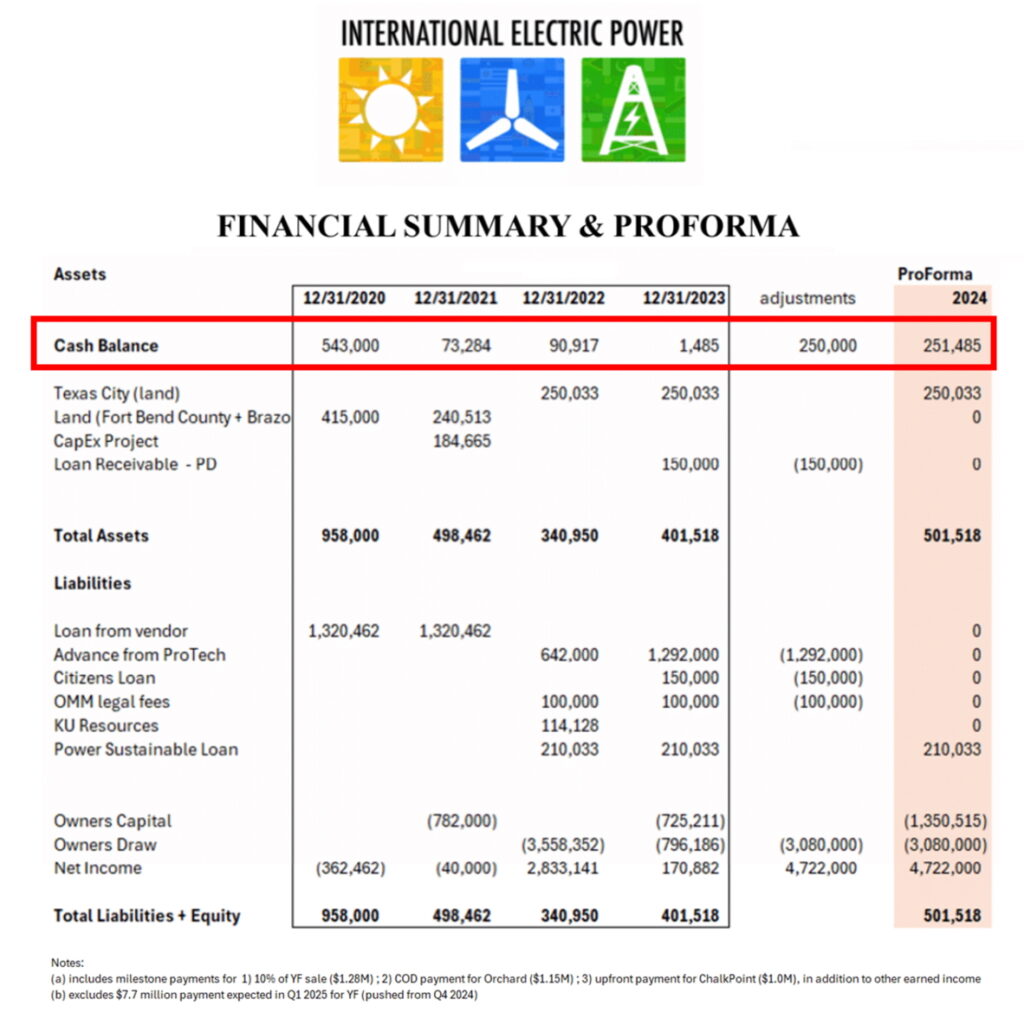
A Majority of IEP’s Claimed Employees Don’t Work at IEP
IEP’s website claims they have 6 employees (including Peter Dailey). However, those employees must not be proud of IEP since none of them (except Peter) actually list working at IEP on LinkedIn.
- Michael Firenze – Nope – He’s a director at Webcor
- Dave Spigelmyer – Nope – He’s employed at multiple organizations, but not IEP
- Trent Markell – Nope – He’s a principal at PF Engineers
- John Hamilton – No IEP Listed – But He is the CEO of Myriad Communications
- Andrew (Rewdy) Holstein – Unknown – we couldn’t find a LinkedIn profile for “Rewdy”, but we did find that he was listed as a key employee in 2021 for an attempted Reg A+ offering of a cannabis company.
IEP, Founder, Peter Dailey’s Long History of Tax Liens
Since IEP is reliant on Peter Dailey we thought it was prudent to peak into Peter’s financial history. We uncovered that IEP’s founder appears to be struggling financially too. We found a long history of state and federal tax liens being placed against him.
And in 2023 Peter even got sued and lost for not paying his ~$1,500 car repair bill (see Coraopolis Collision & Repair Service v. Peter John Dailey in Allegheny Court).

We believe the following IEP projects are likely either in Eos’s backlog or pipeline. Former Eos executives told us they are highly unlikely to occur:
- IEP Desert Wren – Local Public Utilities documents show a competitor using lithium ion already won the bid
- IEP claims they were in negotiations for 2 projects in California called Desert Wren 1 & 2
- Desert Wren 1 & 2 in California was for a combined 3,450MWh (250MWh from LADWP + 3,200MWh from Southern California Edison). IEP’s website oddly claims a significantly higher amount of 12,000MWh
- According to public docs, a Blackstone portfolio company, Aypa Power, won the bid for a 3,200MWh project in Feb 2025 using lithium-ion batteries and delivery is expected in 2028
- IEP Blackhawk in Galveston, Texas for 500MWh supposed to come online in November 2026 but given the size of the project we think it’s unlikely IEP will be able to secure the funding
- IEP Robena Mega Site in Greene County, Pennsylvania for 1,820MWh
- We believe this project is very early stage and still requires zoning confirmations, air permits, water and discharges permits, building permits, pipeline and gas laterals, and more
We aren’t as extremely negative on IEP as former Eos employees were as we found two IEP projects that we think are likely to happen/actually could go forward (see Appendix E). We think that only projects that have secured funding and permitting like 48MWh of the IEP Camp Pendleton project should be included in backlog.
Projects Blackhawk, Desert Wren, and Robena Mega Site are extremely costly projects. Former Eos executives do not think IEP will be able to get these projects funded. If IEP’s founder can’t afford to pay his taxes or even his car repair bill, then how can Eos bet investor’s financial future on IEP?
How many of these speculative IEP projects that are unfunded and unpermitted does Eos have hiding in their reported backlog?
Latest Eos Hype: New Customers “Would Consider” Eos Batteries
Eos announced on Oct. 21 two new “deals” to supply batteries to MN8 and Talen Energy. A former Eos C-Suite executive said both sound like the kind of pure hype Eos puts out to inflate its backlog and boost its stock price.
“The typical Eos contract … it’s an MOU, or it’s like, ‘hey, we’re buying this stuff.’ But if you read the fine print, there’s an out” ~Former Eos C-Suite Executive C
Both announcements – here and here — were seriously hedged, saying EOS could supply “as much as” or that the new customers “would consider” using Eos batteries or “aim to identify” “potential sites.”
Nowhere does it say that Eos has locked a deal to sell batteries to either new customer. Former executives told us they highly doubted either came with any financial commitment.
The MN8 announcement, “it’s not a real contract … it’s basically just a bunch of words on a page that mean nothing to me. And so I just think it’s dumb.” ~Former Eos C-Suite Executive C
Eos has also touted their MOU with Frontier Power in the UK for 10GWh of storage which sounds really exciting. But former Eos executives told us it’s “Not real, at least in the next 10 years” and that “there’s no real commitment behind that MOU.”
It’s Not All Fugazi – The Projects That are Legit, Funded, and Permitted:
It’s not all fugazi, it’s an est ~80% fugazi. We believe the true backlog are the following projects:
- IEP Camp Pendleton for 48MWh
- The CEC is funding $42 million for the initial phase of this project (Eos to receive ~$12 million total), and we have obtained 2 separate invoices showing Eos has been paid ~$6 million in 1H 2025
- Naval Base of San Diego for 31MWh
- The CEC is funding $8 million for this project so we think it’s likely to happen
- City Utilities for 216MWh
- City Utilities mentions this project in their 2025 integrated resource plan overview and they have issued bonds to fund this project
- There are posts on twitter showing Eos cubes being delivered to the project sites
- Dominion Energy Virginia 16MWh
- Virginia State Corporation Commission shows this project received approval on May 6, 2024 and Dominion Energy Virginia’s annual report says EOSE’s batteries are “currently on schedule be in service by August 1, 2026
- IEP Damon 50MWh – potential to be non-fugazi as IEP sold this project to private equity firm Power Sustainable in 2022
- The project site was an empty field as of April 2025 but has an expected commercial operation date of August 2026
- “Large Regulated Utility” for an undisclosed amount to power a small microgrid for two schools in Florida
- We believe this is likely Florida Power & Light and view it as real but small
To learn more about Eos’s non-fugazi backlog, see appendix E.
Bridgelink Still in Backlog? – Parent Co Went Bankrupt & Mgmt Now Runs a Lithium BESS MicroCap Paid Stock Promotion
A former senior Eos employee told us that Bridgelink Commodities is still in the backlog as recently as this year. We were shocked. Bridgelink’s parent company, Bridgelink Power, and it related assets being seized by creditors was the lightning rod for investor lawsuits over Eos Energy’s previous backlog issues.
Former employees told us that Joe wants any possible excuse to keep a customer in backlog, even though Bridgelink’s parent co went bankrupt.
“They’re [Eos] still accounting for that amount [1,000MWh from Bridgelink]. I remember that when I was there, they were still very much accounting for that. I remember that specifically being something we talked about as it related to the DOE loan. Like why is this in here [the backlog]?” ~former Eos C-Level Executive C
Bridgelink’s Website No Longer Exists – Public information regarding Bridgelink Commodities & their Eos deal used to be found at bridgelinkinvestments.com (see webarchive) – but the website has been down since 2024.
Multiple Lawsuits v. Bridgelink for Unpaid Debts – Management of Bridgelink, Cole Johnson, and several of his Bridgelink affiliated entities were sued numerous times for not paying their debt. There are lawsuits from investment banks, consultants, insurance companies and other investors.
Bridgelink Chairman now CEO of a pink sheets Paid Stock Promotion…that uses lithium batteries – The Chairman and founder of Bridgelink Commodities was Cole Johnson. Cole was recently named the Co-CEO of Bimergen Energy (BESS) a $35m market cap pink sheets stock. BESS is NOT only a company that reportedly uses lithium-ion but it is also a RedChip company that is a paid stock promotion.
Bridgelink Commodities was Eos’s largest customer in their backlog accounting for 1,000MWh. It feels fitting that a key component of Eos Energy’s backlog potentially still hasn’t been removed even after Bridgelink’s parent company had it’s assets liquidated. Now it appears investors are reliant on the CEO of a penny-stock paid stock promotion that uses lithium-based batteries to be able to execute on past promises to EOSE.
Why is Eos forced to keep all these suspect customers with delayed or dead projects in their backlog? We believe there are 2 primary reasons: Eos’s batteries have significant performance issues and are uneconomic compared to lithium-ion.
PART IV – Eos Batteries Performance Issues – Short Eos Energy
Eos Batteries Are Uneconomic – Customers Disclose Significant Performance Issues: Low Round Trip Efficiency & High Failure Rates
- FOIAs, Eos Customers and Former Executives Reveal Poor Performance Has Plagued Eos’s Biggest Projects
- Pine Gate Stopped Using Eos Batteries After Dealing With:
- Low Efficiency (42-55%)
- High Failure Rates (30-40%)
- Indian Energy Found Eos Batteries Have Shorter Lifespan Than Advertised
- NextEra Received “Frankenstein’d” Batteries That Looked Like “Rats Nests”
Hundreds of pages of FOIA’d documents and interviews with former Eos executives and Eos Customers revealed why Eos keeps suspect customers with delayed or dead projects in their backlog: Eos batteries do not work as advertised. We were told about:
- Low “round-trip efficiency” of 42-55% = money lost
- 30-40% failure rates
- “Premature tripping” – Batteries that stop working before they’re fully discharged
- Batteries that degrade faster than expected, shortening their lifespan
- Thermal events + Off-gassing deadly hydrogen bromide gas
“When you have low efficiencies, you’re basically losing money” ~former Pine Gate Engineer
Pine Gate Found Eos Batteries Had Terrible Round Trip Efficiency
Round Trip Efficiency (RTE) measures the energy you get from the battery versus what you put in. It is maybe the most important battery performance metric, and it drives project economics for customers. Low efficiency directly translates to money lost.
Eos promised Pine Gate batteries with RTEs around 75%. But Pine Gate employees told us that the batteries Eos delivered has RTEs in the 42-55% range.
“My round-trip efficiency here is shit. Like what is going on?” ~former Pine Gate Executive
We were also told that 30-40% of EOSE’s batteries failed at Pine Gate’s project, and that the batteries would just shut off with 20% of a charge remaining, meaning they weren’t providing the full 4-hours of energy they were meant to supply. The batteries couldn’t maintain a set charge without degrading, too.
Additionally, Pine Gate employees told us Eos batteries would short across electrodes and overheat and emit toxic hydrogen bromide gas.
“[Eos batteries] didn’t work as advertised … the batteries were working but they were highly inefficient … We did quite a bit of work to get the batteries to like 52%. I think that was the best that we could do” ~former Pine Gate Engineer
FOIA Reveals Z3 Battery Degradation & Premature Tripping Issues
We FOIA’d the California Energy Commission (CEC) and got access to their internal notes regarding EOSE’s Indian Energy project called Viejas. The commission’s notes reveal EOSE’s Z3 battery had performance issues regarding the battery’s state of health (SOH) indicating capacity degradation and reduced lifespan, as well as batteries prematurely tripping.

Interestingly enough, EOSE advertised their battery to Indian Energy as having 75% RTE (same as advertised to Pine Gate). Since Indian Energy began commissioning the batteries in Oct 2025, we expect them to have RTE issues in the near future as the batteries ramp up.
We also learned that EOSE had an off-gassing event take place on Indian Energy’s site.
“We had a couple [off gassing events] in California I believe, at Viejas”~former Eos Operations Executive B
Formers Say Eos Sent NextEra Batteries That Looked like a “Rat’s Nest” And Had to Be Replaced
“Some of them were Frankenstein’d...you send them [NextEra] 1 or 2 energy blocks that look like a rats nest when you open the door and they’re done with you” ~Former Eos Operations Executive B
Former EOSE employees revealed EOSE sent NextEra Energy batteries that were “Frankenstein’d” and looked like a “rat’s nest” to NextEra’s Torrecillas wind project in Texas.
NextEra sent those batteries back to EOSE and formers told us Eos had to send completely new batteries.
Satellite images corroborate these issues with the batteries delivered to NextEra. The images show earlier in 2025 that batteries were on site one month and then removed the next one.
- Batteries were originally delivered in December 2024
- They were all completely removed by Mar 2025
- Before finally being re-installed by May 2025

High Failure Rate & Off Gassing in Greece = Angry Customer
Former EOSE employees also told us their batteries failed internationally. Eos used to have a customer out in Greece called Motor Oil Hellas. But the batteries they received apparently had “such a large failure rate” and the customer was stuck warehousing these batteries “for like a year.” It’s no surprise the customer did not continue with the project.
We were also told that EOSE “had some [off gassing] in Greece.”
“[The Greek Customer] literally had to warehouse all of the damaged batteries in Greece for like a year. And they were getting pissed because they couldn’t get these things out of Greece. And it was a lot of flippin batteries. ~ former Eos Safety Executive ~former Eos Safety Executive E
PART V – Lithium-Ion Batteries Are Better & Cheaper – Short Eos Energy
Eos Batteries Are Uneconomic vs Competition – Lithium Performs Better & Is Cheaper
- Lithium Dominates Due to Cost Reductions & Performance Improvements – Lithium Price Declined by >80%
- Eos Batteries Est to Cost At Least 2x More Than Lithium
- Lithium Has Better Round-Trip Efficiency Than Eos
- Eos Actual RTE ~30-35% Lower Than Lithium Competitors
- The Other Zinc Bromide Battery Co’s Went Bankrupt
Lithium-ion battery prices are significantly cheaper and perform better than Eos’s batteries. That explains why instead of Eos pumping out batteries and profits they instead are pumping out press releases on potential deals.
Lithium Cost from Competition is Est to Be >50% Cheaper
Battery experts and former employees told us that they estimated lithium batteries are at least 50% cheaper than Eos’s batteries today. Lithium is significantly cheaper even after significant tariffs.
- “I’d be surprised if lithium is not twice as cheap [as Eos] today” ~former Eos C-Level Executive D
- “Biggest problem [for Eos] is the sales price of lithium batteries… add your tariffs and taxes puts it at $175/kWh” ~former Eos Manufacturing Executive F
- “Once you take the public funding away, I will go out on a limb here that the market share of the non-lithium technologies will drop to zero because nobody is able to match the installed cost of lithium-ion battery system ~Ph.D Zinc Bromine Battery Expert
Eos Battery’s claim to have longer lifespans than many lithium-ion competitors. So we also did an analysis on the long-term cost of ownership. From our own levelized cost of storage calculations we estimate Eos’s batteries cost at least ~30% more than a lithium-ion competitor after considering investment tax credits. Long-term Eos batteries are still way more expensive, and that’s assuming they work.
Lithium Price Has Declined >85% in Recent Years
“The problem [Eos] are having is price pressure from the lithium world. They had expected lithium costs to go up or at least stay flat. They never expected lithium [prices] to come down” ~former Eos Operations Executive A
Lithium Price has declined significantly in recent years due to new supply coming online and weaker demand out of China, the world’s largest buyer of lithium.
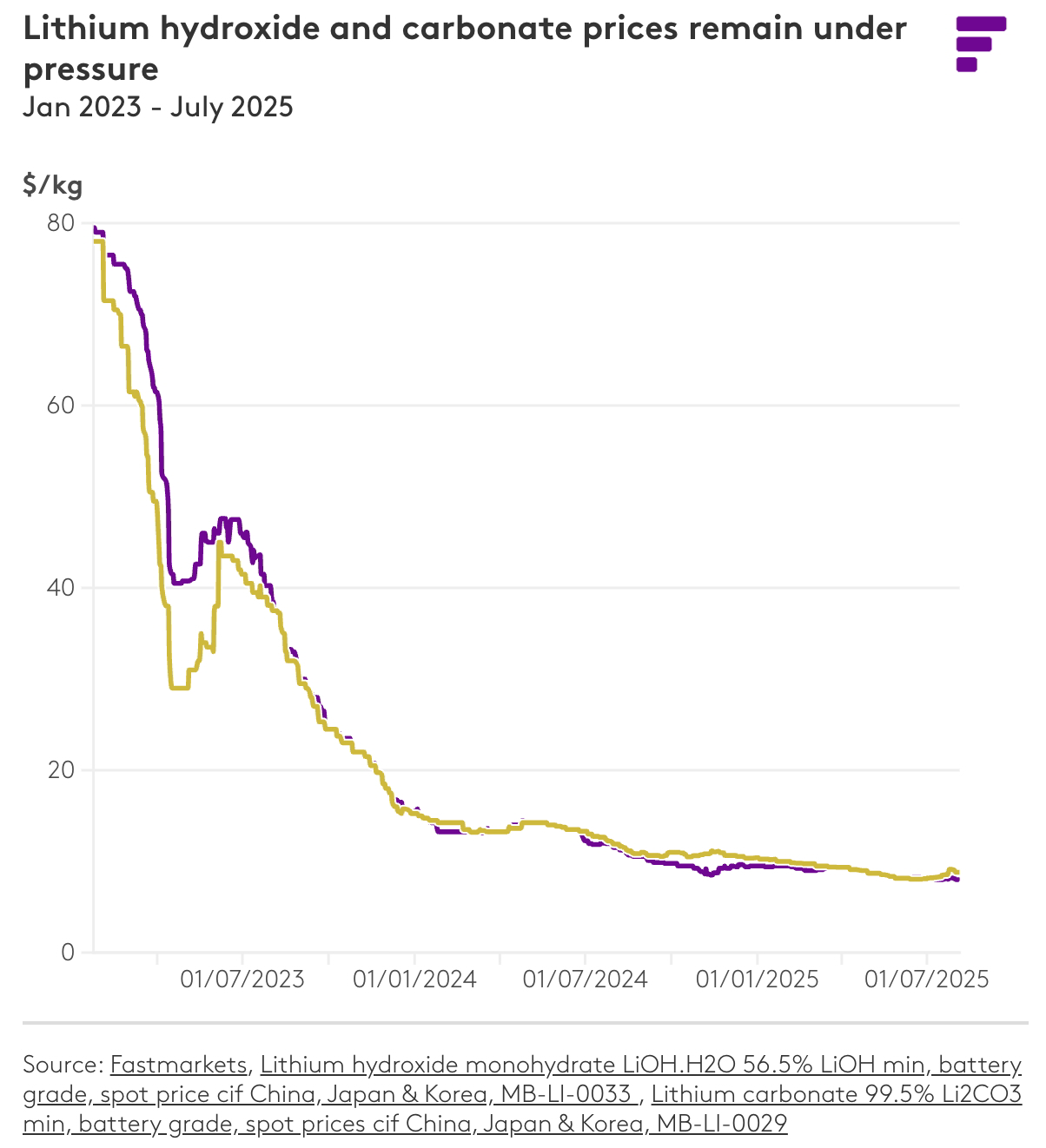
Lithium-Ion Batteries Perform Better & Easily Installed
Round Trip Efficiency (RTE) is a huge drive of long-term cost – the lower the RTE, the higher the operating cost per battery.
Eos’s lithium competitors, report RTE’s that are 90% or better:
- Tesla’s Megapack = 93.7%
- BYD =>88%
- GE Vernova = 93%+
As a reminder, Pine Gate employees told us their Eos batteries had a RTE 42%-55%, and that RTE’s that were <60% actually made the Eos battery’s a money losing proposition.
Other Zinc Bromide Battery Co’s Ended in Bankruptcy Due to Bad Economics
Redflow Limited – Aussie based zinc-bromine battery co (RIP Oct 2024) – Redflow was an Australian based battery tech co that also developed zinc-bromine flow batteries. Redflow managed to raise funding from the California Energy Commission (CEC) and previously had a project with Faraday Microgrids, before EOSE did.
Redflow went bankrupt and ceased operations in October 2024. Former executives cited problems with material costs, labor costs, manufacturing costs, according to a former executive at the company. They told us that zinc based battery technology was way more expensive than lithium ion alternatives and could not compete.
Primus Power – Silicon Valley based zinc-bromine flow battery co (RIP Feb 2021) – Primus was another zinc bromine company but despite >$110 million in funding it liquidated in 2021. The main reason they failed was due to lithium-ion competition. Similar to Eos, Primus touted a 20 year life and 70% RTE but a California Public Utility Commission report shows that after converting to AC-AC, the RTE actually dropped to 62%.
Our takeaway is that zinc battery’s competing against high-performance low-cost lithium-ion batteries is not only difficult, but it’s a recipe for bankruptcy. Even free government money and subsidies can’t make up for bad business economics.
PART VI – No Positive Gross Margin in Sight – Short Eos Energy
Eos Batteries Are Uneconomic – Material Costs Higher Than Sale Prices, Even at Scale
- Former Employees Revealed Eos’s Material Costs – Say Eos Will NEVER Be Gross Margin Positive
- Sale Prices Keep Declining Too
We discovered Eos’ true underlying unit economics by talking with former employees, and they are worse than Eos wants investors to believe. Our estimates show that Eos will NEVER be Gross Margin positive.
The best thing Eos could do for a short seller is sell more batteries. The more batteries they sell, the more money they lose!
Former employees, some of whom were directly involved in manufacturing, agree. They said that unless pricing increases and material costs plummet, then they don’t think Eos will generate positive gross margins let alone net income. Pricing isn’t increasing, it’s been declining rapidly.
“Do I ever think they’ll get to gross margin positive based on their cost structure right now… I don’t think so” ~former Eos C-Level Executive C
While Eos does occasionally disclose a breakdown of direct production costs, the information is vague, and we believe it is intentionally trying to hide how unprofitable its system really is.
“The proof is in [Eos’s] margin. It doesn’t exist and hasn’t existed for years. So at some point the clock runs out ~former Eos Manufacturing Executive F
Eos Spends $180k on Materials to Make a Battery; Sells for Far Less
Former Eos executives told us direct materials alone currently cost ~$180,000 to produce a cube. Formers said they were sold to NextEra for just $68,000 per cube.
“To produce each cube is ~$180,000 [of direct materials] … the stuff that was sold to NextEra was sold for … $68,000 per cube versus the $180,000 it takes to produce it” ~former Eos C-Level Executive C
Best Case At Scale = Est NEGATIVE 43% Gross Margins; Direct Material Costs Alone Are > Selling Price
“At operational max, they’re [Z3 battery] somewhere in the $350 [per kWh] range… I think out the door is around $400/kWh” ~former Eos C Manufacturing Executive D
Formers guided us on material prices so we could create our own estimates for each battery. Using the breakdowns they provided gave us a similar result. The below estimates are what we believe is the best-case scenario. According to sell-side analysts and our own research, Eos typically sells its batteries for ~$250/kWh. We found:
- Direct material costs run ~ $284/kWh, or 14% more than Eos’ average sales price
- Total costs, including transport & installation, run ~$358/kWh, or 43% above ASP!
For the best case we use Eos management’s estimates for direct labor and manufacturing overhead at scale (of only 5.2%) and estimates for indirect costs which include a quick installation in the field. Even then we estimate Eos will generate NEGATIVE 43% Gross Margins.
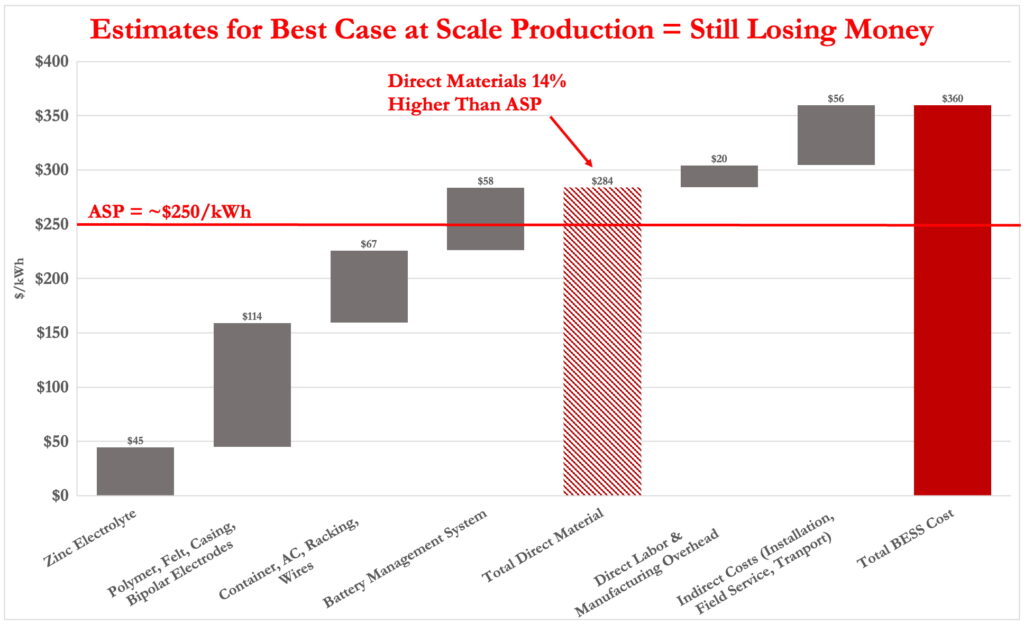
To learn more about Eos’s battery unit economics so you can generate your own economic estimates please see appendix B.
Manufacturing & Installation Issues = Actual Costs Way Higher
Former’s helped guide us as to how to build out the best case scenario above, but they constantly emphasized that those numbers are still too optimistic. The reasons they cited were related to all the manufacturing and installation challenges that Eos has continued to experience which drive costs higher.
- High Battery Failure Rate – “I would probably say a 30% to 40% failure rate [of the batteries]” ~former Eos Safety Executive E
- Simple Manufacturing Issues – “There’s dust particles in the air that are screwing with, getting attracted to the magnetic material in the felt that screwed up all these cells” ~former Eos C-Level Executive C
- Low Uptime for Automated Line – “The uptime for that automated line is only around 65%” ~former Eos Operations Executive A
- High Scrap Rate – “the scrap rate has been completely unacceptable…[it’s] absolutely double-digits right now” ~former Eos Operations Executive A
- Installation Issues – “an installation was an absolute nightmare, there were always issues getting it up and running” ~former Eos C-Level Executive C
Eos’ Pricing Declining – Prices DECLINED by 38-68%
FOIA’d invoices and other documents show that Eos’ prices have been declining for years. The Implied price in Eos’s Q2 2025 stated backlog is ~$250/kWh. But given that former’s executives estimate 80% of Backlog is bogus we think investors should model pricing to be even lower than that.
Over the last 3 years realized pricing has DECLINED by between 38-68%
- 2022: Eos sold batteries to Indian Energy for $357/kWh
- 2024: Eos sold batteries to Indian Energy for $280/kWh
- 2025: Eos sold batteries to IEP for $250/kWh
- 2025: Eos sold batteries to NextEra for est ~$113/kWh
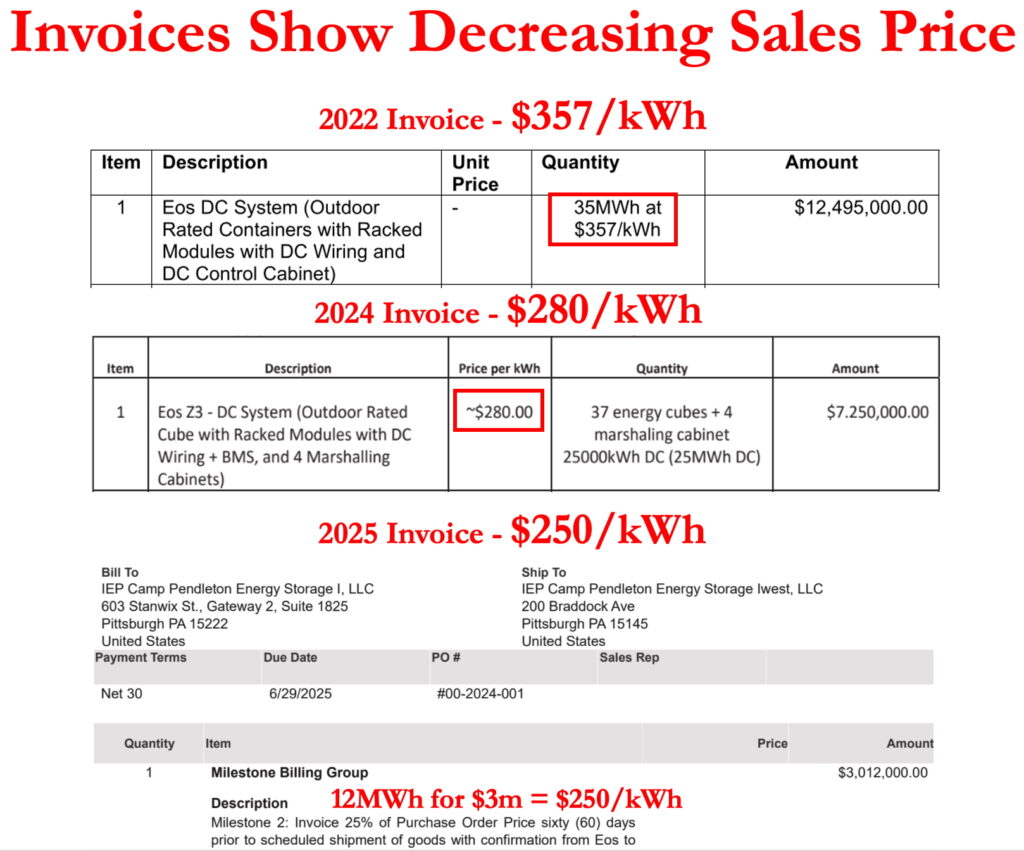
PART VII – Scared Money Don’t Make No Money – Short Eos Energy
Joe Mastrangelo’s Weak “Moral Compass;” Execs Who Push Back Risk Being Fired
- Eos Has had 4 CFOs and 3 CCOs in 5 Years
- Formers Said CEO Insists Defunct Projects Stay in Backlog, Refused to Write Down Obsolete Inventory
- “There are things in Eos’ backlog that they know aren’t going to happen.”
In the last 5 years, Eos has had 4 CFOs, 3 CCOs. Former executives told us there is one main reason: CEO Joe Mastrangelo. Multiple former employees informed us that Joe berates staff at all levels, and delivering negative news in a meeting risked getting a dressing down or even fired.
“Current leadership, I’ve never felt had a really strong moral compass” ~former Eos Operations Executive B
Former executives said Mastrangelo would do everything he could to avoid having to publicly report material information that was negative about Eos, such as removing a customer from its backlog.
“Negative news can’t be given…you’re honestly in some ways you’re putting your job at risk if you give negative news at all … [Joe] will fight to come up with a logic that says that he doesn’t have to be able to announce something negative” ~former Eos C-Level Executive D
One former called Joe Mastrangelo “the worst person I ever worked for” another told us “We’re all afraid to wake up to the horse in our bed.”
Mastrangelo Insisted No Bad News in Text or Email – If It Was Not Written Down, He Wouldn’t Have to Announce It
Former Executives also told us that Joe insisted that nothing about the backlog be put in text or email. They said that gave him the room to try to find a rationale for not reporting any changes the backlog.
“He doesn’t want anything associated with the backlog in texts or emails“…
“If I put that down in an email or in a text, then and Joe doesn’t want to announce that at the next earnings call, and then I’ve just put him in an uncomfortable position that he can’t not announce it.” ~former Eos C-Level Executive D
You know who does not want to put anything in writing? People who have multiple sets of financials that they report to different people.
Scared employees don’t make no money.
Mastrangelo Previously Accused of Misleading Investors at GE
Mastrangelo was previously the CEO and President of GE’s Gas Power Systems. A 2019 investor lawsuit that was later dismissed accused Mastrangelo of making false and misleading statements regarding GE’s H-class turbines. But the allegations of Joe hiding manufacturing defects and significant product issues seem very similar to what we have heard from former Eos employees.
PART VIII – Financial Restatement Necessary? – Short Eos Energy
Financial Restatement Necessary? Formers Say CEO Needs to Write Down Inventory & Restate Revenue
- Eos Replaced Faulty Batteries & Counted Them as New Sales
- Unusable Battery Fluid Left in Inventory, Not Written Down
- Former Executive Estimated ~25% of Inventory Useless
Former Eos C-Suite executive’s informed us that they believe Eos has “double counted” revenue booked from NextEra and that the CEO refuses to write down obsolete inventory, specifically unusable battery fluid. We believe that auditors could require Eos to restate their financials and take a significant inventory write-down as a result.
Eos “Double” Counted Revenue from Batteries it Had to Replace
In late 2024, Eos delivered batteries to NextEra’s Torrecillas wind project in Texas. Former employees told us that the battery blocks were terribly put together “they looked like rats’ nest’s” and that the unusable products needed to be replaced. We learned that CEO, Joe Mastrangelo, did not want to restate the revenue from the returned units so instead Joe allegedly instructed Eos’s finance employees to “double” count the revenue.
It was a “double counting thing with NextEra. The NextEra deliveries had come back and we reshipped different units … the stuff that got brought back needed to be taken out of revenue from a prior period and restated … but ultimately Joe did not want to do that, did not want to have a restatement” ~former Eos C-Level Executive D
Write-Down Obsolete Supplies Coming? ~25% of Inventory
A former Eos C-Suite executive also told us Eos ended up with old electrolyte in its inventory that was unusable as Eos changed its formula earlier this year. They said it was never going to be used and should have been written down, but Mastrangelo insisted it be kept on the books. The total obsolete electrolyte + other battery parts was an estimated ~$11 million or ~25% of Eos’s reported Q2 inventory.
CEO Mastrangelo “didn’t want to write off inventory … a bunch of it was electrolyte material that was kind of worthless because we were using a new formula … but [Joe] won’t allow inventory to be taken down” ~former Eos C-Level Executive C
PART IX – Large Guidance Miss Coming – Short Eos Energy
Large Guidance Miss for FY 2025 & More Disappointment for FY 2026
- Eos Should Cut FY 2025 Guidance on Q3 CC
- FY 2026 Revenue ~95% Below Wall Street Est
We believe Eos has low to no chance of hitting their FY 2025 guidance and will be forced to cut FY 2025 guidance on their upcoming Q3 earnings call or significantly miss Q4/FY 2025 estimates.
Eos provided revenue guidance of $150-190 million for this year. We estimate that in best case scenario that Eos generates ~$106 million in revenue this year which is ~$64 million short of their guidance mid-point-aka Eos will MISS guidance by ~37%.
Multiple former Eos executives told us they thought guidance should be cut. One even burst into laughter when we asked if they could hit guidance
“If they don’t revise guidance downward this quarter…I just don’t think they’re being very responsible … I don’t think they’re doing the right thing if they don’t revise guidance downward” ~former Eos C-Level Executive C
Our estimates for FY 2025 are built on Eos recognizing revenue from the remaining 50% of the Camp Pendleton 48MWh project, commissioning revenue from their Indian Energy project and delivering 100% of the City Utilities 216MWh project.
FY 2026 Revenue Est ~95% BELOW Wall Street Expectations
For FY 2026 our analysis of Eos’s actual backlog shows the only projects of reasonable size Eos is likely to recognize revenue from are:
- 16MWh project with Dominion Energy Virginia,
- 31MWh Naval Base of San Diego project funded by the CEC,
- Potentially 50MWh from IEP Damon as it’s owned by a private equity firm now.
- We think Camp Pendelton Phase II is unlikely to occur because financing for the project is 100% reliant on IEP.
These are the only projects we have seen that are funded, permitted and potentially can be delivered on. These projects amount to a mere estimated ~$24 million in revenue vs Wall Street estimates of ~$480 million.
FY 2026 revenue is estimated to be 95% BELOW Wall Street Estimates.
PART X – Cerberus Wins, Common Shareholders Lose – Short Eos Energy
Cerberus Wins Even if Eos Shareholders Lose
- Cerberus Structured Deal in a Way They Can’t Lose
- Misrepresenting Financials to DOE = Default on Cerberus Loan Too
- Cerberus Deal Says They Can Short & Hedge
Eos shareholders act as though Cerberus saved the day. The reality is far from it. Cerberus structured the deal so it’s a win-win for them regardless of how things ultimately turn out for Eos common equity shareholders.
Eos assigned “substantially all of their respective assets” as collateral for the Cerberus loan.
Event of Default on Cerberus Loan Too by Misleading the DOE?!?
We believe Eos defaulted on their Cerberus loan by making false representations about their financials to the DOE, another Eos creditor. As a reminder, Former Eos senior executives told us that Eos keeps different sets of financials that are materially different and presents the different financials to the DOE, Cerberus, and their own Board of Director’s.
Sending another creditor false or misleading financials would violate “Events of Default – Term 8.1(d): Breach of Representations.” Sending the DOE a separate different set of financials would trigger an Event of Default on the Cerberus Loan too.
Former Senior Eos Execs Say Cerberus Has Been Misled, Too
It turns out the DOE was not the only party that got a separate set of financials. We were told Cerberus also got sent different financials by Eos management that mislead Cerberus about the real timing of cash flows. Specific examples involved Joe telling Cerberus they would get financial deposits from customers in the near future when the reality was that Eos didn’t even have a contract in place with that customer yet.
We were informed that Eos has also potentially violated a major technology milestone for Cerberus that they reported as competed. In this situation, Eos evidently were supposed to prove certain capabilities of the Z3 battery in the field at a certain scale. Instead, Eos presented Cerberus data from a small test done in their own lab. Pine Gate’s performance issues show the field is way different than the lab. It is unclear if Cerberus management is aware of these misrepresentations or not.
Cerberus Can Short Eos Stock & Hedge Their Position
Cerberus is an incredibly sophisticated financial player. Obviously, they are not going to accept the same downside risk that Eos common stock investor’s currently face.
Cerberus has extended their “lock-up” to June 2026, but investors don’t realize a crucial clause—Cerberus can SHORT EOSE’s Stock!
We believe Cerberus’s ability to short/hedge their EOSE position is one of the major reason’s Eos Short Interest has increased steadily since the deal was struck
Cerberus also has downside protection (exhibit 10.3), unlike common shareholders. Their 43 million “penny warrants” come with protective features such as:
- Cashless Exercise of warrants means Eos shareholders get diluted while the company receives no money.
- Anti-Dilution Protection gives Cerberus more warrants if Eos sells cheaper equity. Essentially, if Eos dilutes shareholders, Cerberus gets made whole.
Common shareholders have been significantly diluted over the years, and much of it has come from Cerberus. On a fully diluted basis, Eos has ~535 million shares outstanding which puts its market cap at ~$8 billion at a $15 stock price.
PART XI – Comps Indicate 88% Downside for EOSE – Short Eos Energy
Comparable Valuations Indicate -88% Downside for EOSE
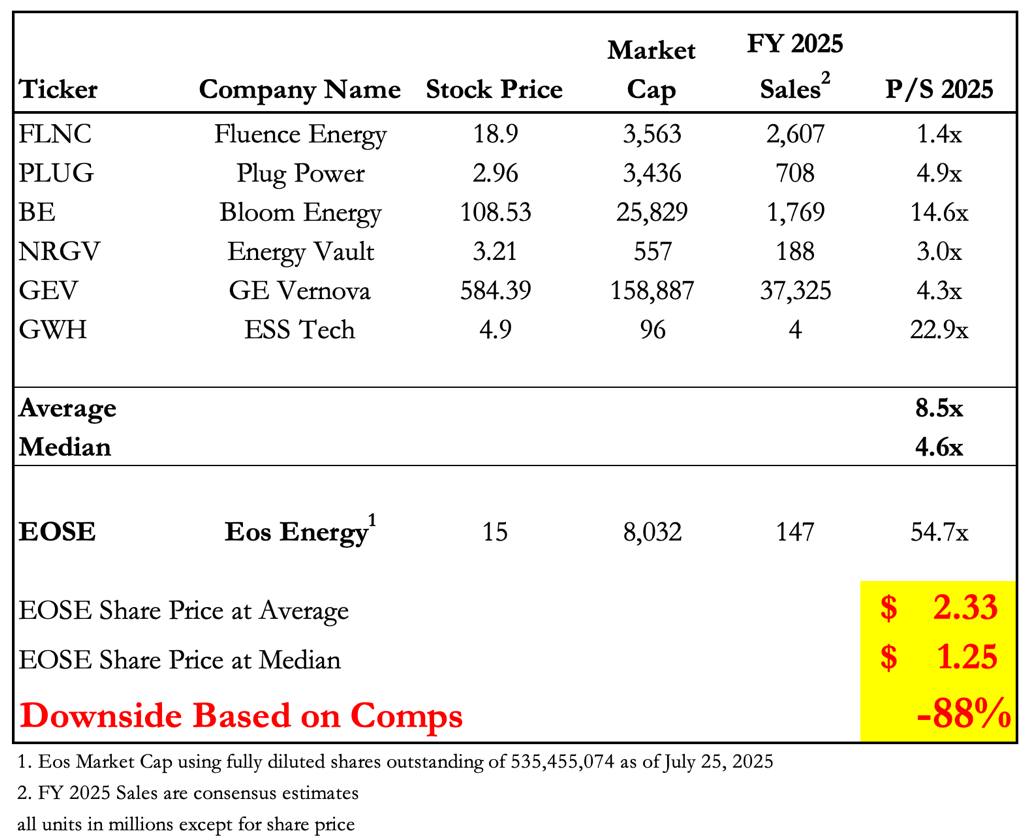
Conclusion – Short Eos Energy
Conclusion – Short Eos – Multiple Sets of Financials Can’t Save Eos From Bad Economics, Low Demand, and A Deadly Gas Problem
We are short Eos Energy (EOSE) because we uncovered that:
- Eos keeps multiple sets of their financials and has allegedly been sending false and/or misleading financial statements to the DOE.
- This would be a clear “Event of Default” on their DOE loan and we believe the DOE will call for the debt to be repaid immediately.
- Eos batteries have an undisclosed issue with thermal events causing gas leaks of potentially deadly hydrogen bromide gas. This has occurred >10 times to our knowledge.
- Eos’s true underlying unit economics are horrific. The company loses lots of $ on every battery they sell. Even at scale Eos will be significantly Gross Margin Negative
- Former C-level executives detailed to us the CEO’s business practices of manipulating financial results and projections in a way that we believe go way beyond the grey area.
- Customer told us the batteries also do NOT perform up to management’s promises and detailed major technical performance issues.
- Formers say the backlog is ~80% worthless. Even with money losing economics Eos’s demand is still anemic. Eos management has taken to reporting a backlog filled with unviable customers, and failed projects.
- The backlog is still stuffed with LOI’s that are “contemplated contracts” and agreements with company’s who are considering bankruptcy, who’s parent co’s have already gone bankrupt, and even ones who have switched to lithium ion.
Any single one of the above reasons make a strong enough case to short EOSE. But when they are all combined together they make EOSE one of the most compelling short opportunities we see today.
EOSE is massively overvalued because retail investors have erroneously labeled the company as a pick-and-shovel for AI. The problem with that is the major utilities and investors actually driving the AI datacenters revolution do NOT “Pick” Eos. Investors have set themselves up to get a shovel to the face now that Eos needs to hit impossible FY 2025 and FY 2026 numbers.
We are not sure if the DOE loan being pulled or the company’s plain old bad economics will be the final death nail for Eos Energy. But it’s coming and bogus backlog promises can’t save them.
Fuzzy Panda Research is Short Eos Energy (EOSE)
Appendix A – Missing Air Permits Could Result in Long Factory Shutdown According to Former Executives & FOIAs
- Formers Says Eos Needs Updated Air Quality Permit But Didn’t Apply For Them
- No Permit Could Result in Factory Being Shut Down For 12-36 Months
Former employees detailed for us the potential risk of missing air permits causing a Eos to get potential 12-36 month shut-down. Getting the essential factory permits seems like basic blocking and tackling. But like all other things that Eos management doesn’t disclose there could be different motive.
A former Eos executive explained to us that prior to automating their manufacturing line at their Turtle Creek facility, Eos’ air emissions “were right at [the] red line,” allowing Eos to receive an air quality permit exemption.
But after automating its manufacturing line, Eos would be required to inform Allegheny County that their air emissions exceed the threshold level and then get a permit, according to a former Eos executive.
“You do your FOIA to Allegheny County … if they come back with nothing, there’s like no air permit … then that’s a fucking problem … how exactly are you operating without an air permit, especially given the chemistry that you’re working with?” ~former Eos Safety Executive E
We FOIA’d Allegheny County and they came back and said there’s no permit.
They said Eos was still relying on the exemption it received back before automating the plant increased its emissions. That exemption hasn’t been updated and thus Eos’s factory is operating without the necessary environmental permits.
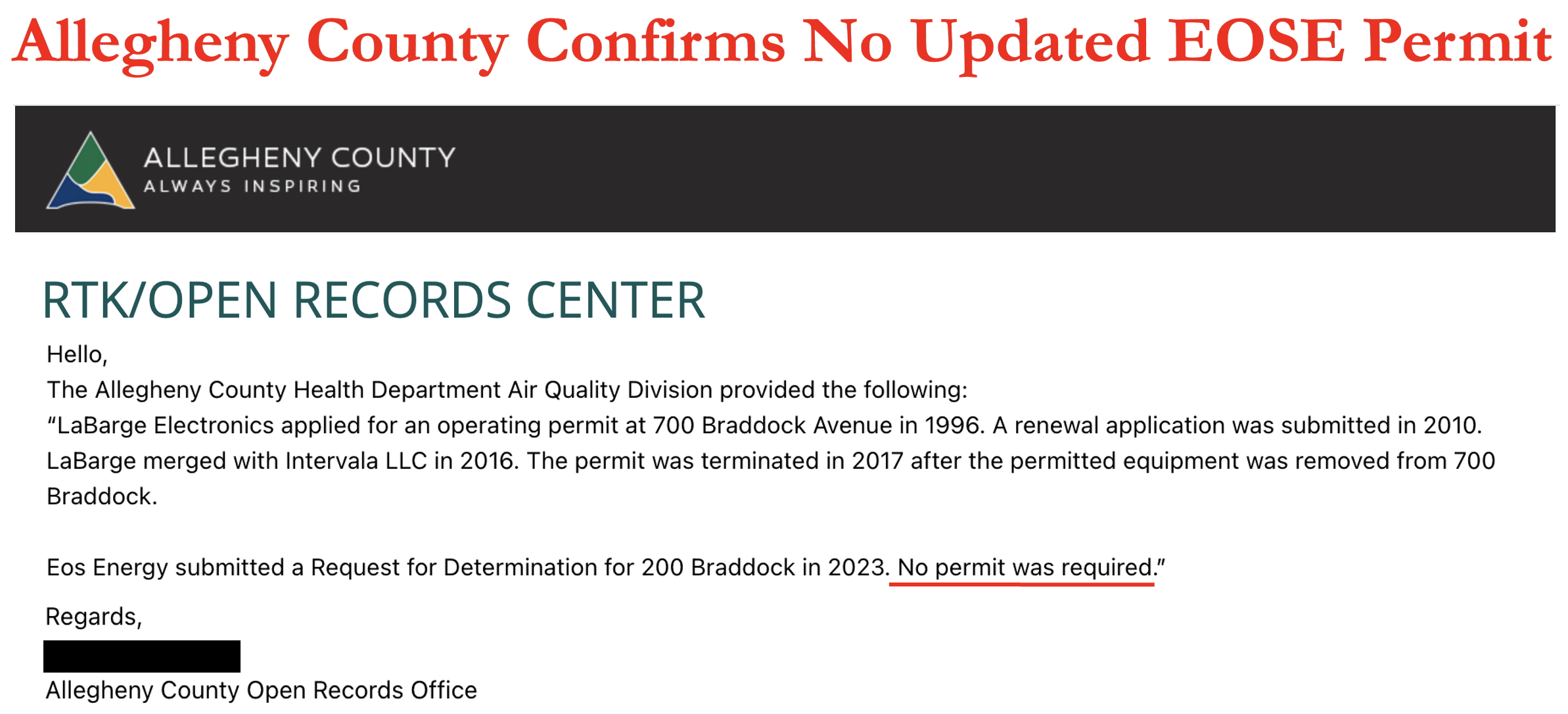
Appendix B – Bad Battery Unit Economics – Est from Former Employees
Through our conversations with former Eos executives and zinc-bromide battery experts, we discovered Eos has little to no chance of becoming gross margin positive. Our best-case estimates using Eos Direct labor estimates at scale show it will cost Eos ~$215,000 or ~$358/kWh to produce a cube.
- “They still have a big anchor around their neck with the assembly of the cube and then with all the work spent month after month with field services trying to get that commission up and running” ~former Eos Operations Executive A
- “Battery companies always make this claim. Once we’re at volume and we’re producing gigawatt hours blah, blah, blah, the cost will be like 0% of what it was. That ain’t going to happen. It’s a catch 22. You can’t get to volume when you’re not selling and you can’t sell because your unit cost is too high” ~Ph.D Zinc Bromide Battery Expert
- “Lithium-ion installed is about $300/kWh. Any flow battery is way, way north of $1,000/kWh installed” ~Ph.D Zinc Bromide Battery Expert
We estimate the total cost of a cube to be ~$215,000 at scale, or ~$358/kWh. It comprises of:
- The zinc electrolyte assumptions that former Eos employees suggested we use are:
- That the zinc electrolyte costs ~$40-$60/kWh
- Eos pays Tetra ~$5/kg for their zinc electrolyte. And a few extra $/kg for their solutions from their other vendors, so assume ~$8/kg all in for the zinc electrolyte
- AI estimates there to be between 5-12kg of electrolyte in each module
- To be conservative we only assume 5kg of electrolyte are in each module, so $40/module
- The Z3 has 672 modules, or ~$27,000 worth of electrolyte, or $45/kWh
- Eos uses lots of plastic in their battery modules. They use a conductive plastic polymer collector, polypropylene felt, and the module itself is encased in plastic.
- Eos used to use titanium coil as the current collector but switched to a conductive polymer for the Z3 model, reducing costs
- Formers said the amount of plastic costs Eos ~$3/lb which includes the module casing, the polypropylene felt, inserts to make the electrodes, and the conductive polymer current collector
- And each battery module is 45lbs, and there are 672 of them in each cube
- The zinc electrolyte accounts for ~11lbs (5kg) so the remaining ~34lbs are for plastic
- So each cube has ~$68,000 worth of plastic and felt
- Eos needs to package all 672 modules into a large shell container and add racks, an AC system and ventilation, wires and gauges, etc
- We were told the shell container itself costs $20,000-$25,000
- Formers also said the standards for DC voltage have increased from 1,000V to 1,500V meaning heavier wires and switch gears are required, adding to cost
- And after adding racks, the AC system, wires and gauges, we were told the container costs Eos ~$40,000
- Then to make the batteries operate, it needs a battery management system which we were told is very expensive
- Although the BMS is software, it requires hardware as well
- We were told the BMS costs ~$30,000-$50,000
- We assume a cost of $35,000
So all in, the direct materials alone cost Eos ~$170,000 per cube to manufacture. Automating manufacturing will not reduce these costs.
Then there are direct labor and manufacturing overhead costs. The direct labor costs have decreased significantly as Eos has brought automated manufacturing online. But they haven’t automated the part where humans have to load all 672 modules into the storage container. And we were told there’s little chance of this becoming automated. Based on Eos’ disclosure of direct labor and manufacturing overhead we estimate it costs ~$11,000.
Then there are indirect costs. Eos has had issues with installation and field services costs. We were told that field engineers have already been at NextEra’s Torrecillas site for over a year. We heard similar stories from Pine Gate. At scale, we assume Eos will be able to reduce field work down to one month which is typical with other installations of similar technologies, according to former employees. We were told Eos pays their field engineers ~$40-$50/hour and should have 2 employees working ~12 hours per day for a month, which accounts for ~$32,400 of costs. We were told it costs ~$1,000 to transport each cube. So all together, we estimate indirect costs to be ~$33,400 based on what former Eos employees told us.
To convert total costs into $/kWh, we divide the ~$215,000 by 600kWh per BESS from Eos’ disclosure to get ~$358/kWh.
We ran these estimates by multiple former Eos operations experts who confirmed our work and said our estimates seemed very reasonable.
Appendix C – Levelized Cost of Storage Shows Eos Costs Are Still At Least 30% More Than Lithium-Ion In Long-Term
We estimate it costs at least 30% more to own Eos’s batteries than a lithium-ion competitor over the long-term. And that’s including investment tax credits Eos’s customers could qualify for. This long-term cost of ownership for Eos’s customer is referred to as levelized cost of storage (LCOS).
Eos acknowledges their batteries come with higher upfront costs than a traditional lithium-ion battery but argue they’re cheaper in the long-term. We disagree and so does the math. A major driver of the LCOS is round-trip efficiency. And we know Eos has significantly lower RTE than lithium-ion competitors.
Pine Gate told us that Eos marketed their batteries as having 75% RTE. But after experiencing significantly lower RTE’s in the field, Eos came back saying their RTE might be ~63%. In reality it got all the way up to 55%.
We calculate the LCOS using the Lazard method. Using the same assumptions Lazard uses (such as project financing, capital costs, operating costs, etc) but adjusting for Eos’s lower RTE, we estimate it costs customers at least 30% more to own an Eos battery, over a 20-year span.
Appendix D – AC vs DC – Eos uses DC-DC to Overstate Est Round-Trip Efficiency
Round-Trip Efficiency (RTE) is a huge driver of long-term costs. We’ve learned from speaking to Eos customers that Eos’s RTE in the field is significantly lower than marketed to investors and customers.
- Eos tells investors their RTE is 78-91%
- Eos tells their customers it’s 75-80%
- In reality it’s been 42-55%
“I can tell you that a zinc bromide cell has an 80% or 85% efficiency, but that is in a lab environment…and maybe my lab tech had a good day…if a company gives you cell data which is only DC, inherently they either don’t have a fully developed product or they have something they don’t want to tell you…So you always give your best case numbers” ~Ph.D Zinc Bromide Battery Expert
It’s important to note Eos presents their RTE on a DC basis, while customers care about RTE on an AC basis. AC RTE captures inverter losses and auxiliary loads and is measured at the point of grid interconnection, reflecting the actual operating efficiency Eos customers experience.
A California Public Utility Commission report applies a 11% reduction when converting RTE from DC to AC for a zinc-bromide battery. Applying this reduction to Eos’s presented RTE means on an AC basis, their claimed RTE is likely closer to 67-69% for a 4-hour discharge system. And we know from customers it’s been much lower in the field.
Appendix E – The Real Backlog – Some Projects Are Legit But Still Is Not Enough to Beat Guidance
Yes there are real customers in EOSE’s backlog. Most of these projects have been heavily subsidized or fully funded by the California Energy Commission. We just don’t think they’ve realized the poor performance of EOSE batteries and thus are not aware of the undisclosed safety risks inherit in zinc bromide chemistry.
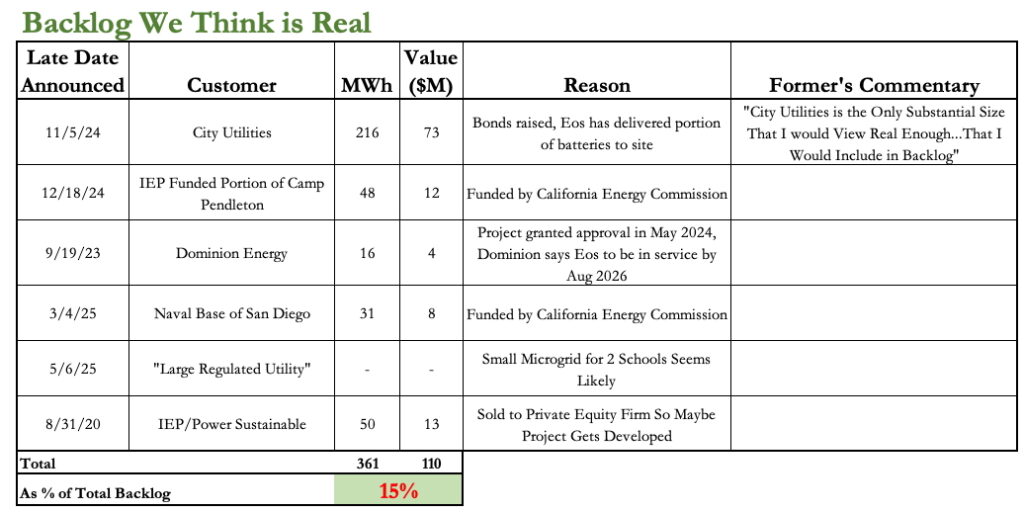
Bulls on EOSE are hoping that FY 2025 guidance is going to be saved by the IEP Camp Pendelton Project. But only 48MWh out of the 400MWh project has been funded. And the CEC told us that project timeline is unknown, and financing for the remaining 352MWh is also unknown.
We FOIA’d the CEC and learned that EOSE already booked sales for 24MWh (50%) of the 48MWh in Q1 and Q2 this year. So we expect the remaining ~$6 million in sales from IEP Camp Pendleton to come in 2H 2025. That won’t help EOSE hit their $170 million mid-point guidance.
For Q3 & Q4 2025, we expect EOSE to recognize ~$80 million in sales. $73 million from City Utilities, the remaining ~$6 million from IEP Camp Pendleton, and ~$800k from commissioning Indian Energy.
Added to EOSE’s ~$26 million in 1H 2025 sales. We expect EOSE will do ~$106 million this year. That’s quite a large miss!
1. City Utilities – Springfield, Missouri
We believe that EOSE will deliver their 216MWh to City Utilities in FY 2025. City Utilities raised funds by issuing bonds specifically for this project back in February 2025. We expect Eos to deliver these batteries in Q3 and Q4 of this year.
2. Dominion Energy
Dominion Energy Virginia selected EOSE for their Darbytown Storage Pilot Project. This is a 16MWh project expected to be operational in 2H 2026.
The project will be testing two new technologies, Form Energy and Eos Energy. Virginia State Corporation Commission shows this project received approval on May 6, 2024. And Dominion Energy Virginia’s annual report says EOSE’s batteries are “currently on schedule be in service by August 1, 2026.”
3. IEP Camp Pendelton – 48MWh Funded by California Energy Commission
The California Energy Commission (CEC) seems to be the most willing organization to fund EOSE’s projects, and the CEC has committed to funding $42 million for the initial 48MWh of this 400MWh project. The CEC told us the timing is still unknown.
Although the timeline is unknown, we do believe Eos will recognize ~$12 million from the 48MWh phase of this project in 2025. However the other 352MWh requires outside funding which former Eos employees told us IEP was unlikely to secure.
4. IEP Damon – Sold to Private Equity Firm
IEP sold this 50MWh project located in Brazoria, Texas, to private equity firm Power Sustainable in 2022. This project has a COD date of August 2026. As of April 2025, the project site remained an empty field. Despite this, there is a chance the project does get developed as it’s owned by a private equity firm now.
5. Naval Base of San Diego
This 31MWh, $8 million project at the Naval Base of San Diego is being funded by the CEC. Once again, the CEC seems to be the organization most willing to fund Eos’s projects.
6. Small Microgrid Order for “Large Regulated Utility”
Eos announced a small microgrid order for two schools in Florida from a large regulated utility. We think this could be Florida Power & Light. Although details regarding the project size were not disclosed, we believe this could be a real order.
We think it’s an outside risk that the county comes back to Eos and forces them to do new testing to qualify and get the correct permits. But the fact that Eos didn’t do the testing ahead of time shows operational issues at Eos. Why would you have an outside risk of having your manufacturing facility closed for 12-36 months?
Fuzzy Panda Research Disclosures, Disclaimer and Terms of Service:
By downloading from or viewing material on this website and/or by reading this report, you agree to the following Terms of Service. You agree that any use of the research in this report or on this website is at your own risk. In no event will you hold Fuzzy Panda or any affiliated party, including officers, directors, employees, consultants, and agents of Fuzzy Panda or any companies affiliated with any of them, liable for any direct or indirect losses caused by your use of or reliance on information on this site or in this report. You further agree that you will not rely on any information in this report or on this website, to do your own research and due diligence before making any investment decision with respect to companies or securities mentioned herein, and that you will consult with your own investment professionals prior to any investment decisions. You represent that you have sufficient investment sophistication to critically assess the information, analysis and opinions in this report or on this site. You further agree that you will not communicate the contents this report or other materials on this site to any other person unless that person has agreed to be bound by these same Terms of Service. If you accessed, download, or receive this report or the contents of other materials on this site as an agent for any other person, you are binding your principal to these same Terms of Service.
As of the publication date of this report, Fuzzy Panda, and possibly any companies affiliated with it or its members, partners, employees, consultants, clients and/or investors (the “Fuzzy Panda Affiliates”), have a short position in the stock (and/or options, swaps, and other derivatives related to the stock) and bonds of the company covered in this report (the “Covered Company”). Fuzzy Panda and the Fuzzy Panda Affiliates therefore stand to realize significant gains in the event that the prices of either equity or debt securities of the Covered Company declines. There are many factors that can go into a decision to cover the short position(s) in the Covered Company’s securities and it is not possible to predict exactly when or for exactly what reasons Fuzzy Panda and the Fuzzy Panda Affiliates may cover their positions, in whole or part, or otherwise change their investment holdings. As a general matter, Fuzzy Panda and the Fuzzy Panda Affiliates intend to cover some or all of their positions at a time that the price of the Covered Company’s securities are lower than when they were sold short or otherwise invested in. Fuzzy Panda and the Fuzzy Panda Affiliates may cover some or all of their short positions immediately after the publication of this report or an indefinite period after its publication. Similarly, Fuzzy Panda and the Fuzzy Panda Affiliates may cover some or all of their short positions if the price of the Covered Company’s securities move a small amount or after moving a larger amount. Fuzzy Panda and the Fuzzy Panda Affiliates intend to continue transactions in the Covered Company’s securities for an indefinite period after the publication of this report, and they may be short, neutral, or long at any time after the publication of this report regardless of any opinions, possible stock prices or valuations, or other views stated in the report. Fuzzy Panda will not update any report or information on this website to reflect any changes in the investments of Fuzzy Panda or the Fuzzy Panda Affiliates that existed at the time of the publication of this report, or any new positions in any securities of the Covered Company.
This report and the Fuzzy Panda website is informational and describes the opinions of Fuzzy Panda. This report is not an offer to sell or a solicitation of an offer to buy any security, and Fuzzy Panda does not offer, sell or buy any security to or from any person through this report or the Fuzzy Panda website. This report is not a recommendation or advice to short or otherwise invest in or trade any security. Fuzzy Panda does not render investment advice to anyone unless it has an investment adviser-client relationship with that person evidenced by a formal written agreement. You understand and agree that Fuzzy Panda does not have any investment advisory relationship with you, or owe any fiduciary or other duties to you. Giving investment advice requires knowledge of your financial situation, investment objectives, and risk tolerance, and Fuzzy Panda has no such knowledge or information about you.
If you are in the United Kingdom, you confirm that you are accessing research and materials as or on behalf of: (a) an investment professional falling within Article 19 of the Financial Services and Markets Act 2000 (Financial Promotion) Order 2005 (the “FPO”); or (b) high net worth entity falling within Article 49 of the FPO.
Fuzzy Panda’s research and reports express the opinions of Fuzzy Panda, which are based upon generally available information, field and online research, and inferences and deductions through due diligence and the analytical process. Fuzzy Panda believes that all information contained in this report has been obtained from accurate and reliable public sources, and no material nonpublic information was obtained from any person who had a duty to keep information confidential. However, Fuzzy Panda cannot be certain that the information it has relied upon in this report is accurate. The information and opinions in this report are therefore presented “as is,” without warranty of any kind, whether express or implied. Fuzzy Panda makes no representation, express or implied, as to the accuracy, timeliness, or completeness of any such information or with regard to the results to be obtained from its use. This report also contains forward looking statements about what may occur in the future. The future cannot be predicted with certainty and any of the forward-looking statements about projections, beliefs, estimates, assumptions, outcomes, or any other future event may be incorrect. Among other things, any forward-looking statements may be rendered inaccurate by incorrect assumptions, incorrect methodologies, unforeseen risks and events, or other variables. Any opinions about the possible future stock price of the Covered Company or fair value of its securities is not a price target and does not mean or imply that Fuzzy Panda or the Fuzzy Panda Associates will hold any investment until such price or valuation is met. Further, all expressions of opinion, including any conclusions drawn from Fuzzy Panda’s analysis, are subject to change without notice, and Fuzzy Panda does not undertake to, and will not, update or supplement any reports or any of the information, analysis and opinion contained in them.
You agree that the expressions of information in this report are copyrighted and owned by Fuzzy Panda Research, and you therefore agree not to distribute this report, any excerpts from it, or information from the Fuzzy Panda website (whether the downloaded file, copies / images / reproductions, or the link to these files) in any manner other than by providing the following link: www.fuzzypandaresearch.com. If you have obtained Fuzzy Panda’s research in any manner other than by accessing or downloading from that link, you may not read such research without going to that link and agreeing to the Terms of Service. You further agree that any dispute between you and Fuzzy Panda and/or any of the Fuzzy Panda Affiliates arising from or related to the material on their website shall be governed by the laws of the State of California, without regard to any conflict of law provisions. You knowingly and independently agree to submit to the personal and exclusive jurisdiction of the state and federal courts located in California and waive your right to any other jurisdiction or applicable law. The failure of Fuzzy Panda to exercise or enforce any right or provision of these Terms of Service shall not constitute a waiver of such right or provision. If any provision of these Terms of Service is found by a court of competent jurisdiction to be invalid, the parties nevertheless agree that the court should endeavor to give effect to the parties’ intentions as reflected in the provision and rule that the other provisions of these Terms of Service remain in full force and effect, in particular as to this governing law and jurisdiction provision. You agree that regardless of any statute or law to the contrary, any claim or cause of action arising out of or related to this report or the material on this website must be filed within one (1) year after such claim or cause of action arose or be forever barred.
